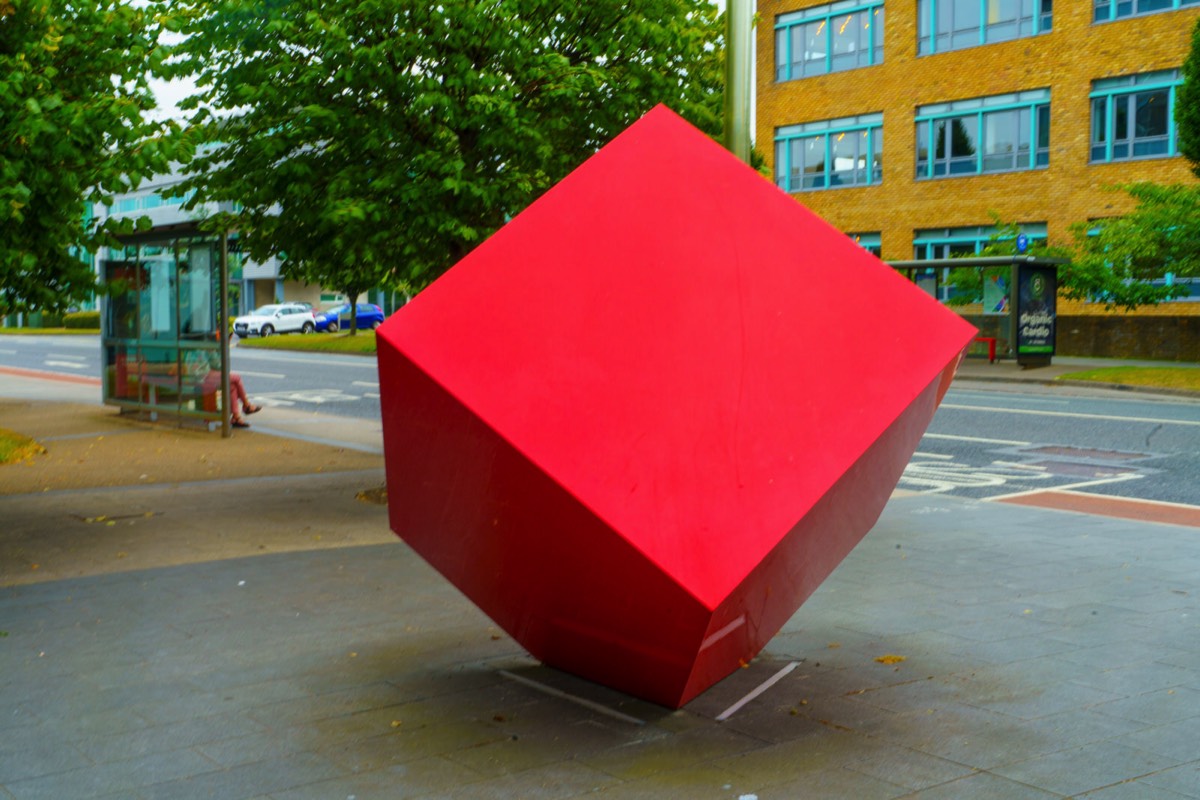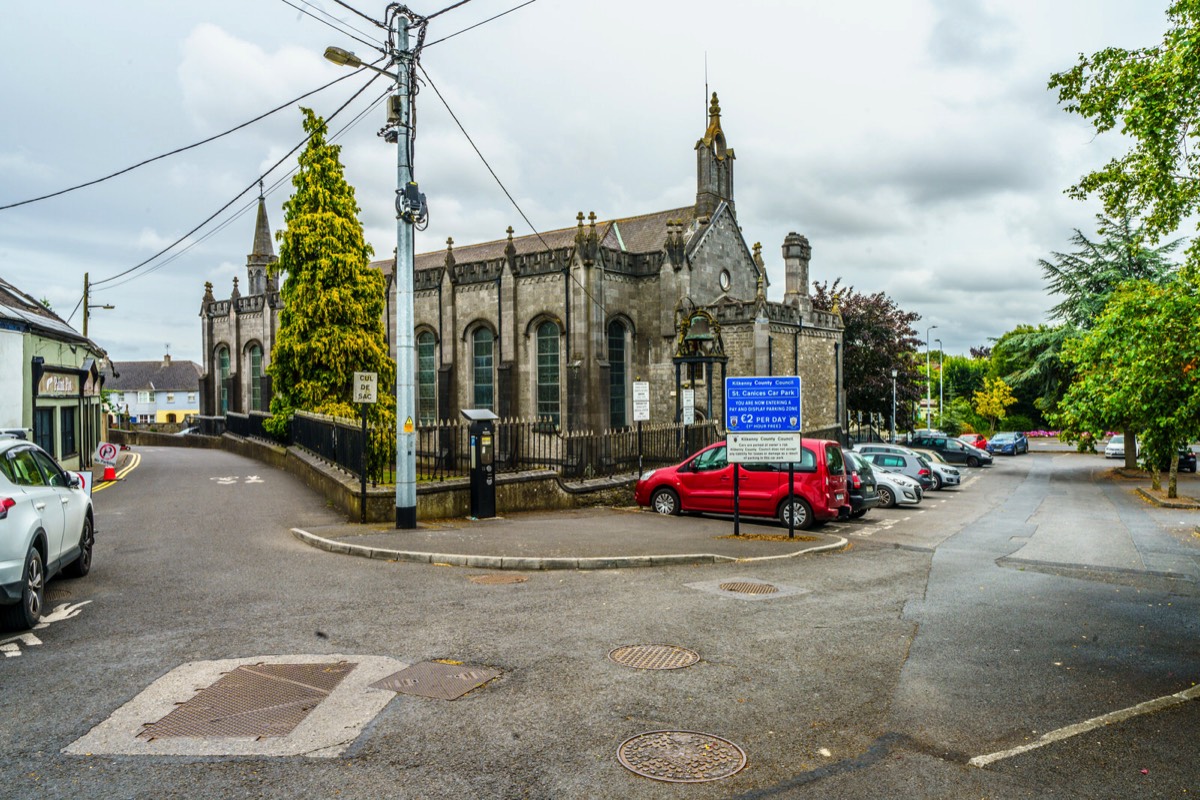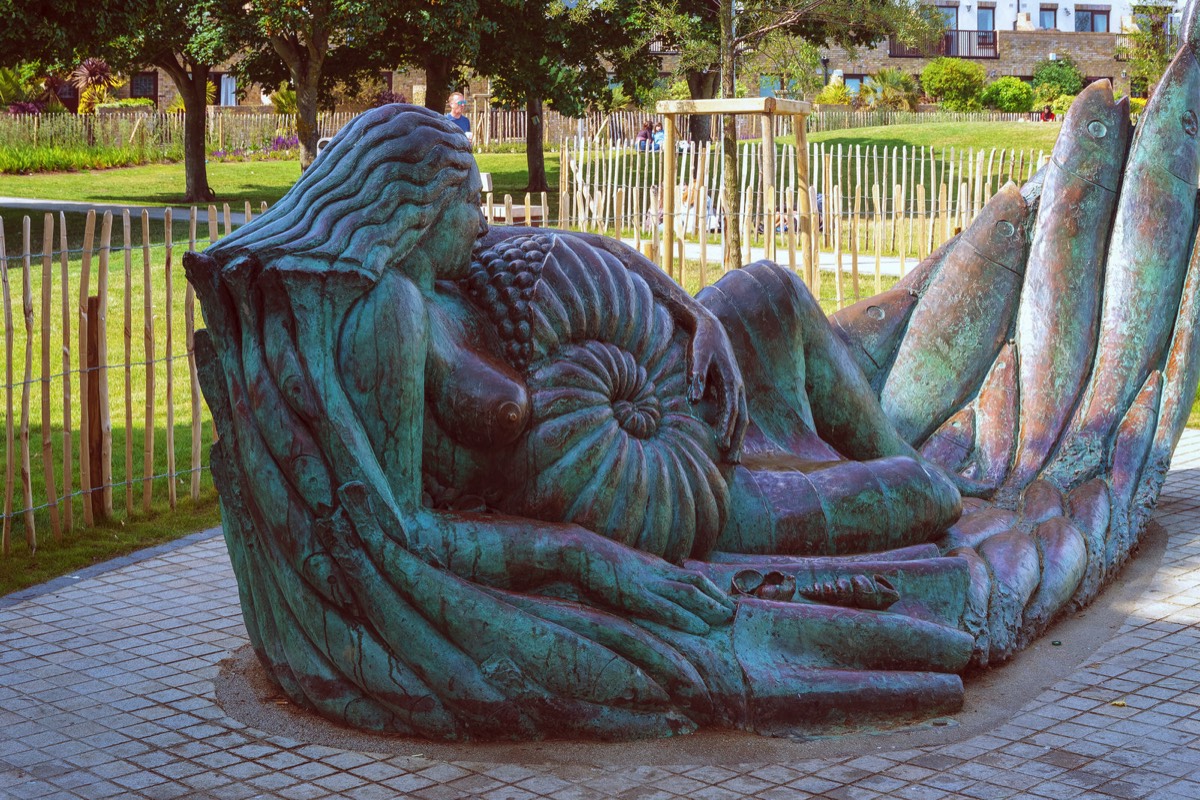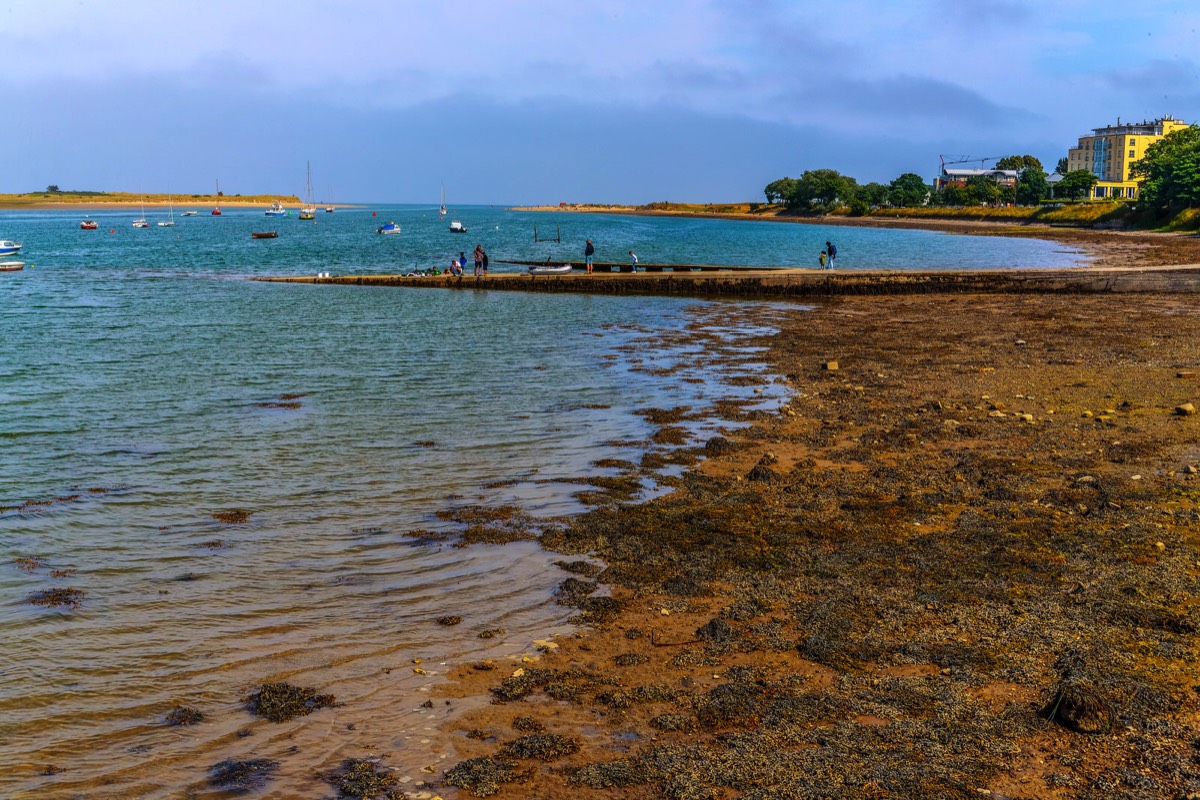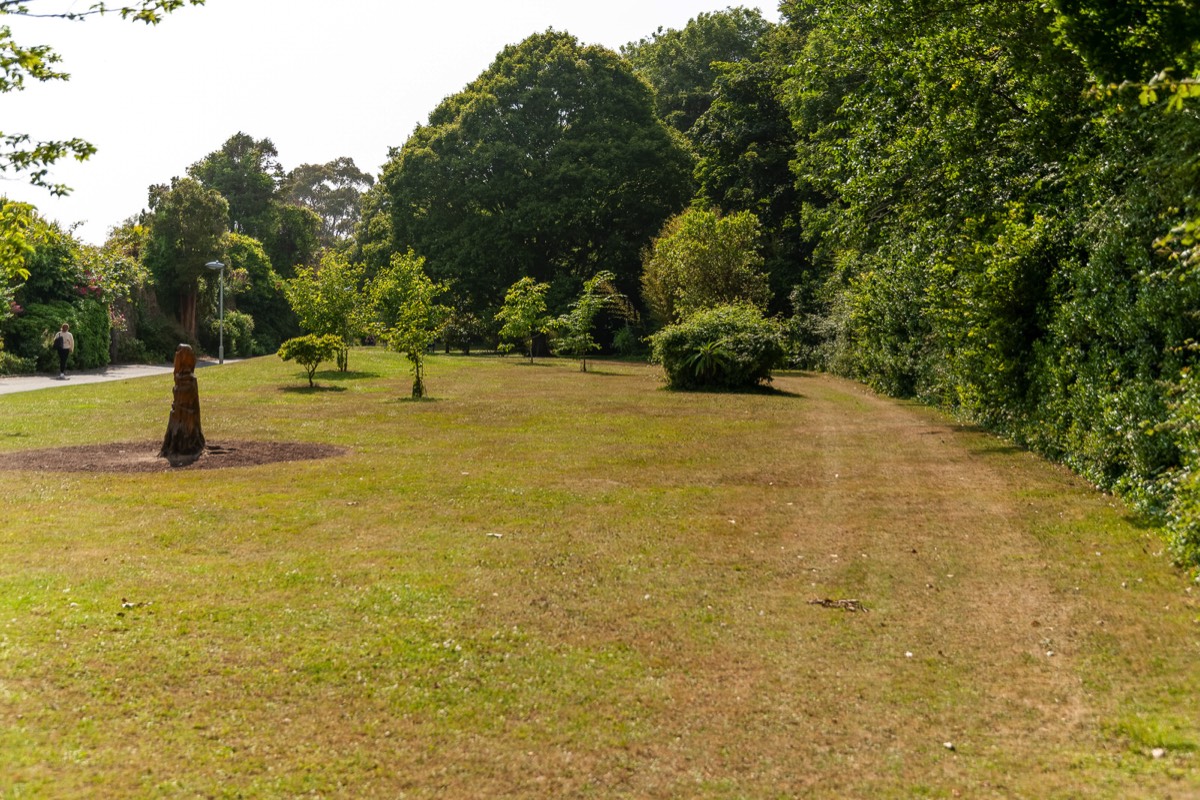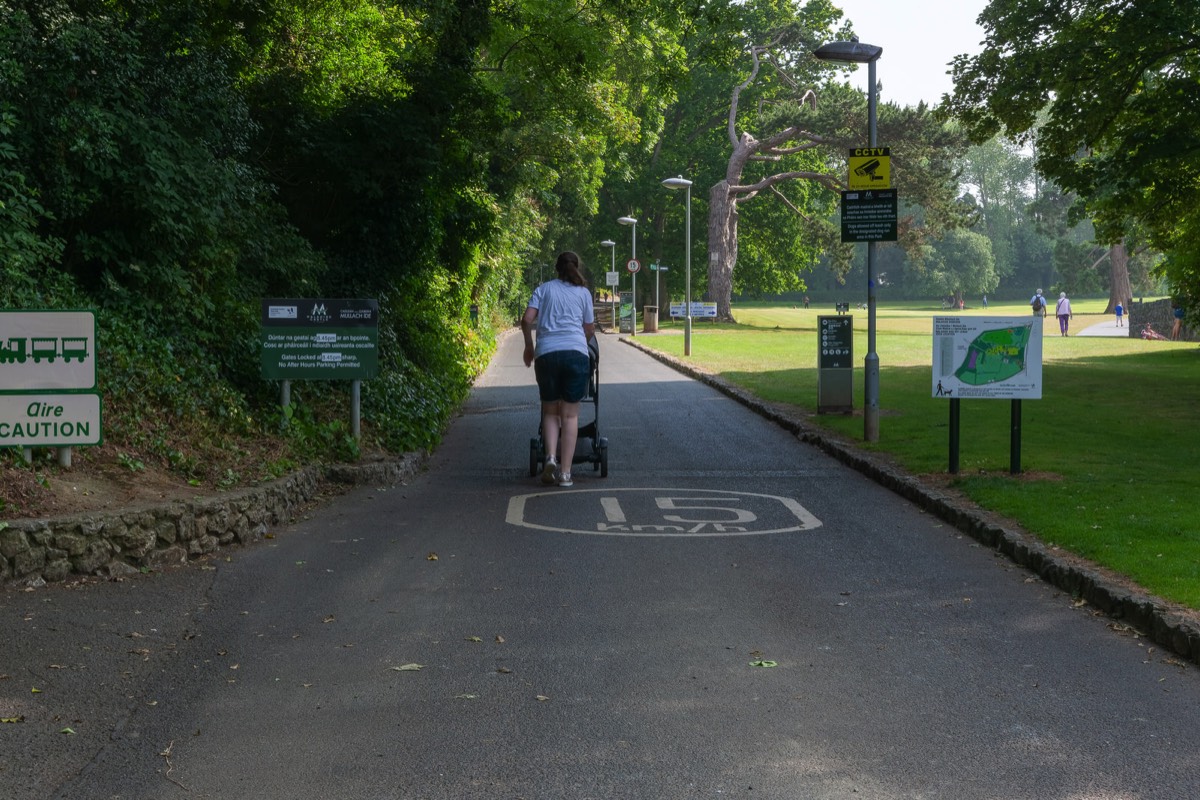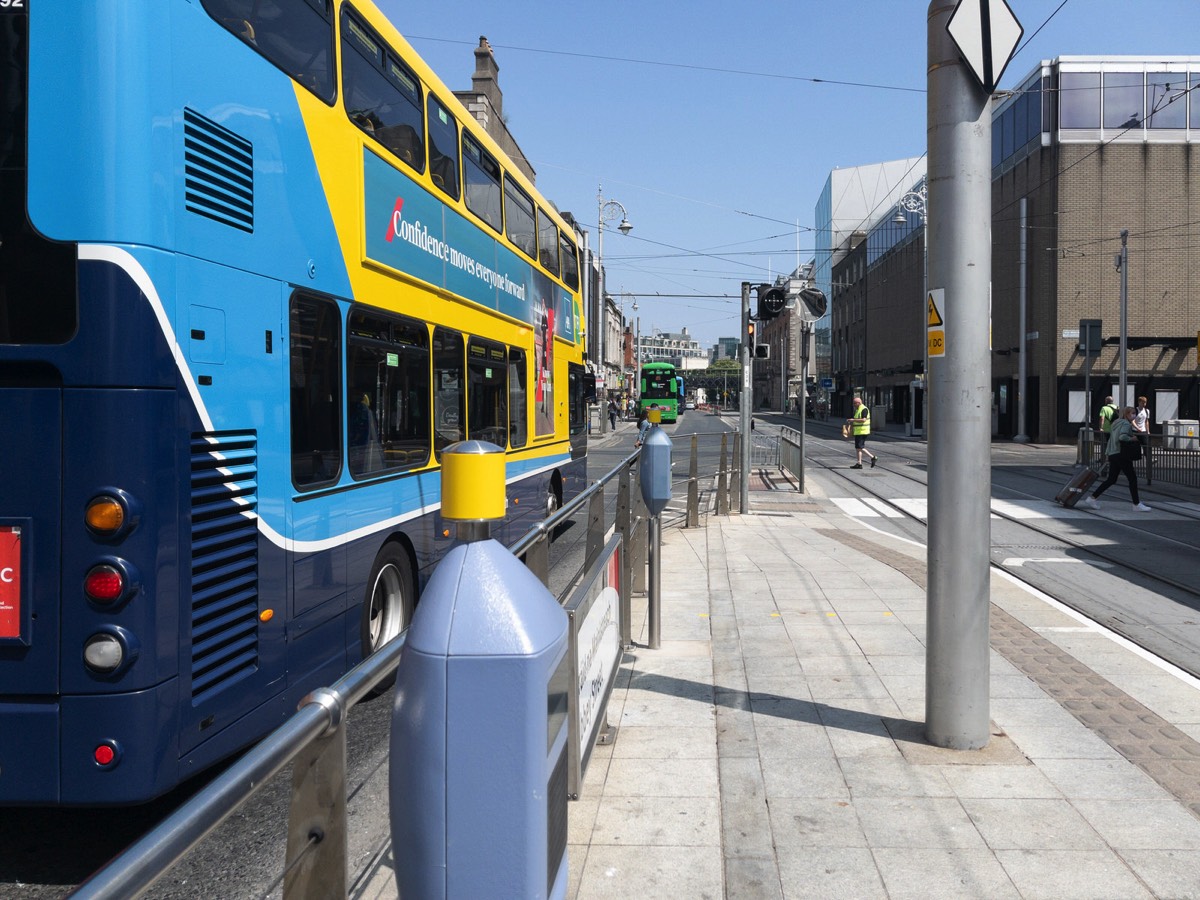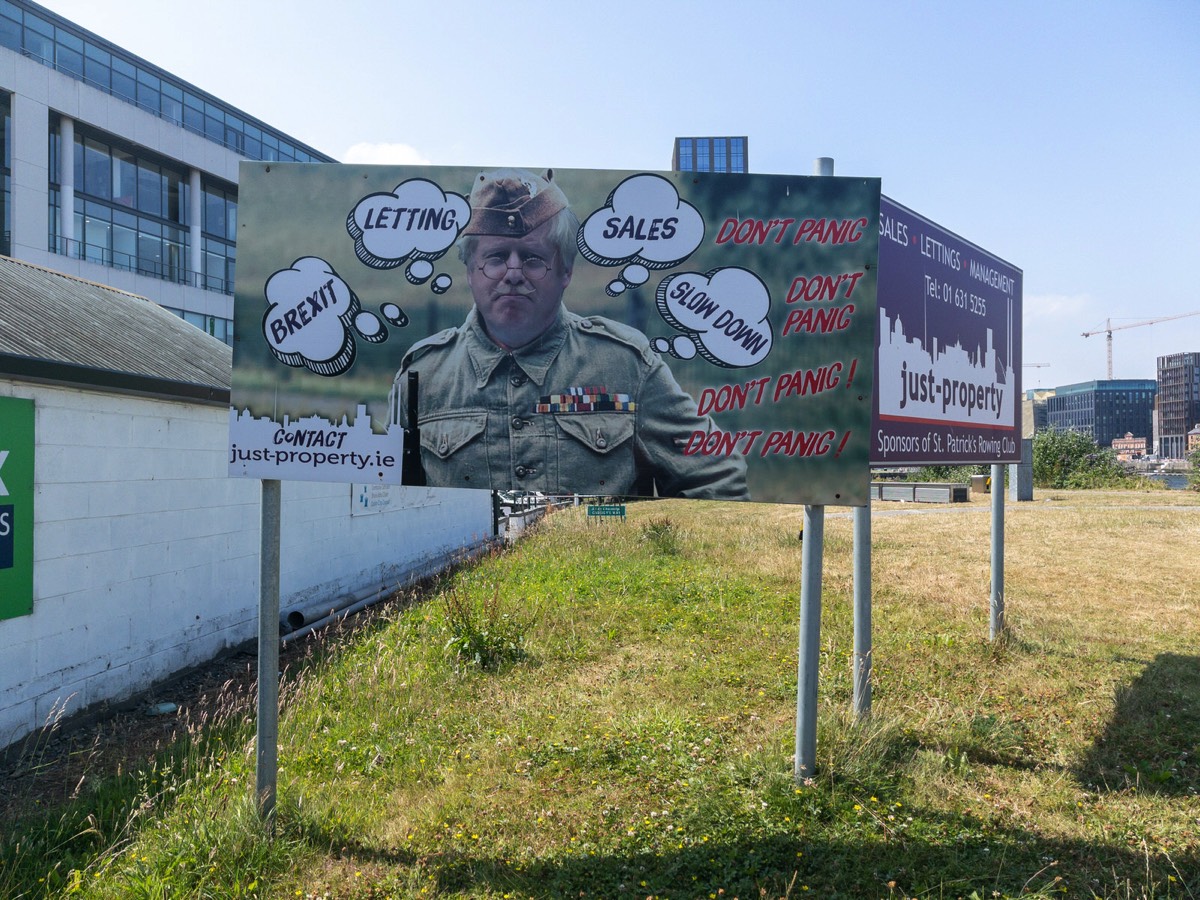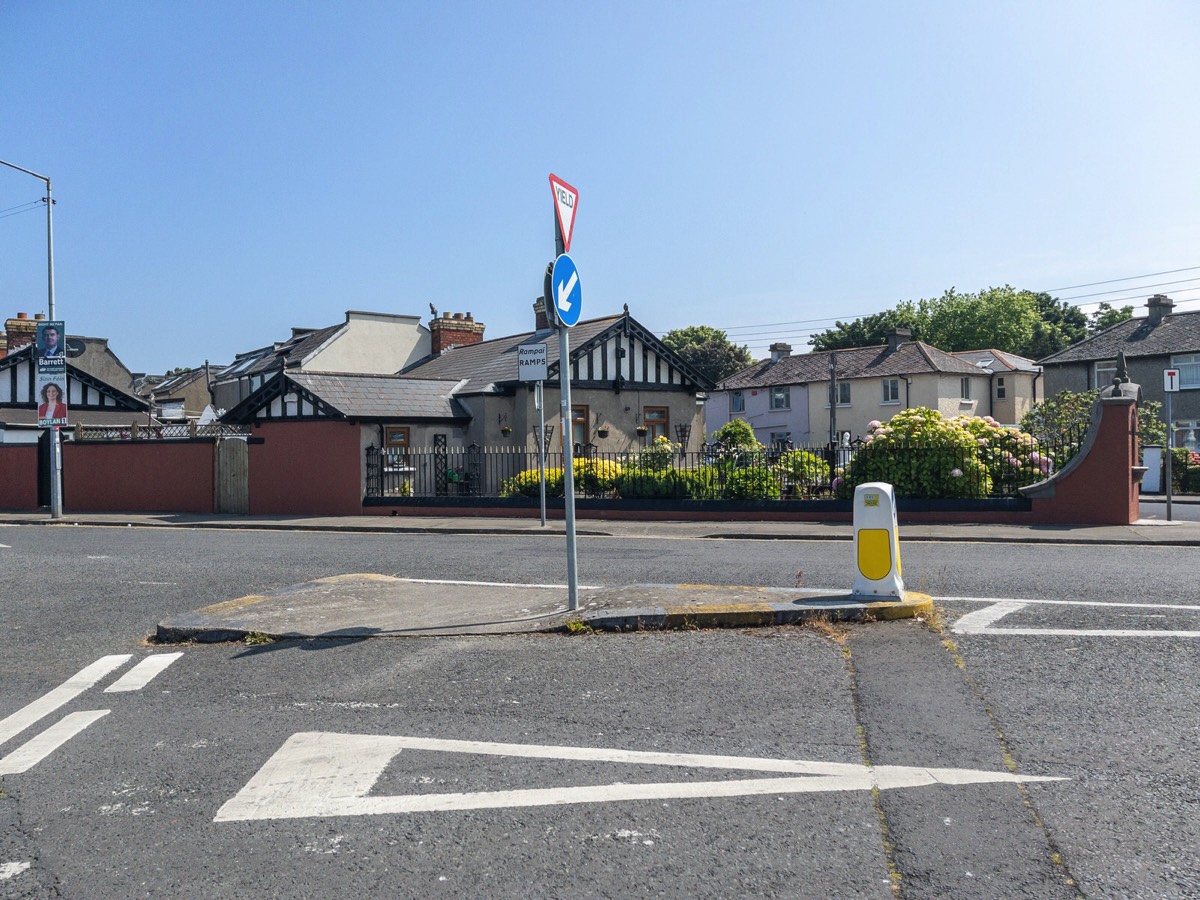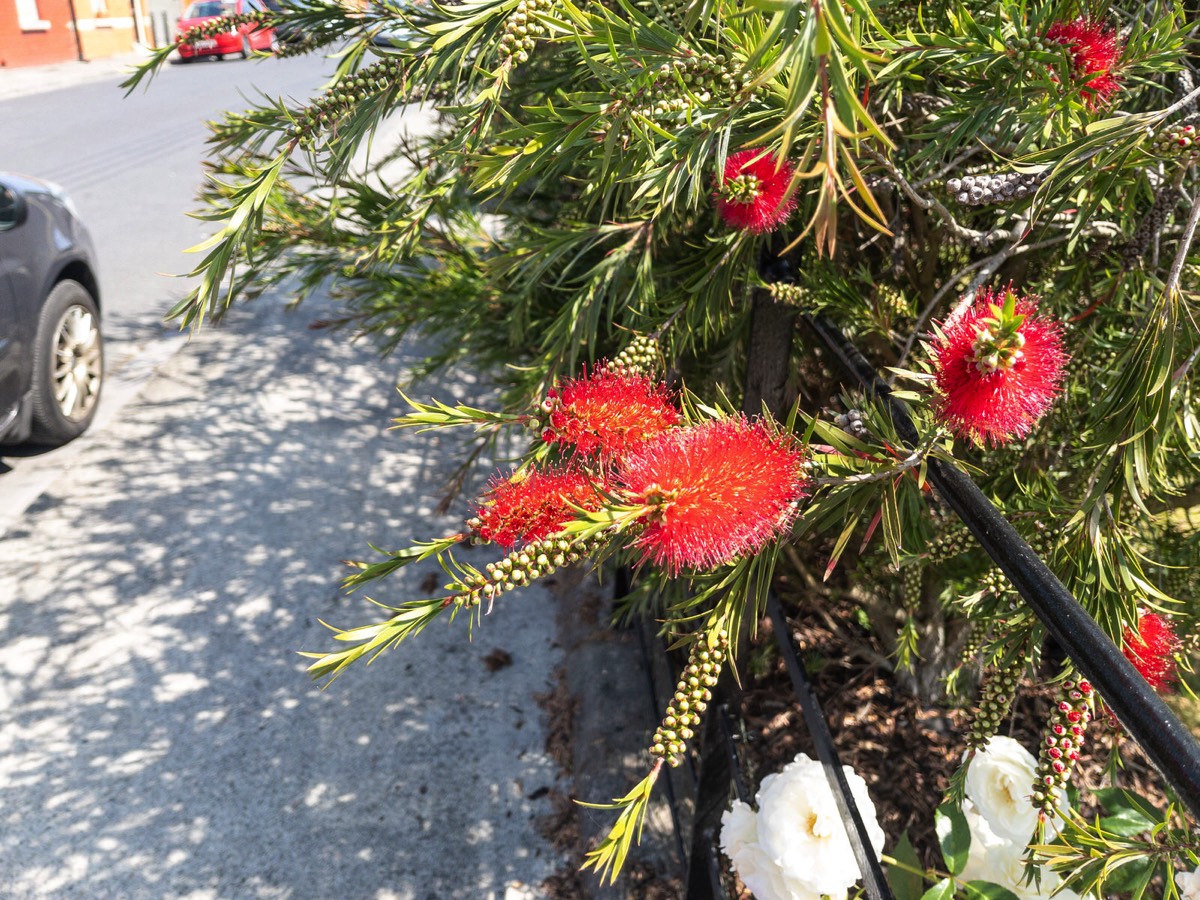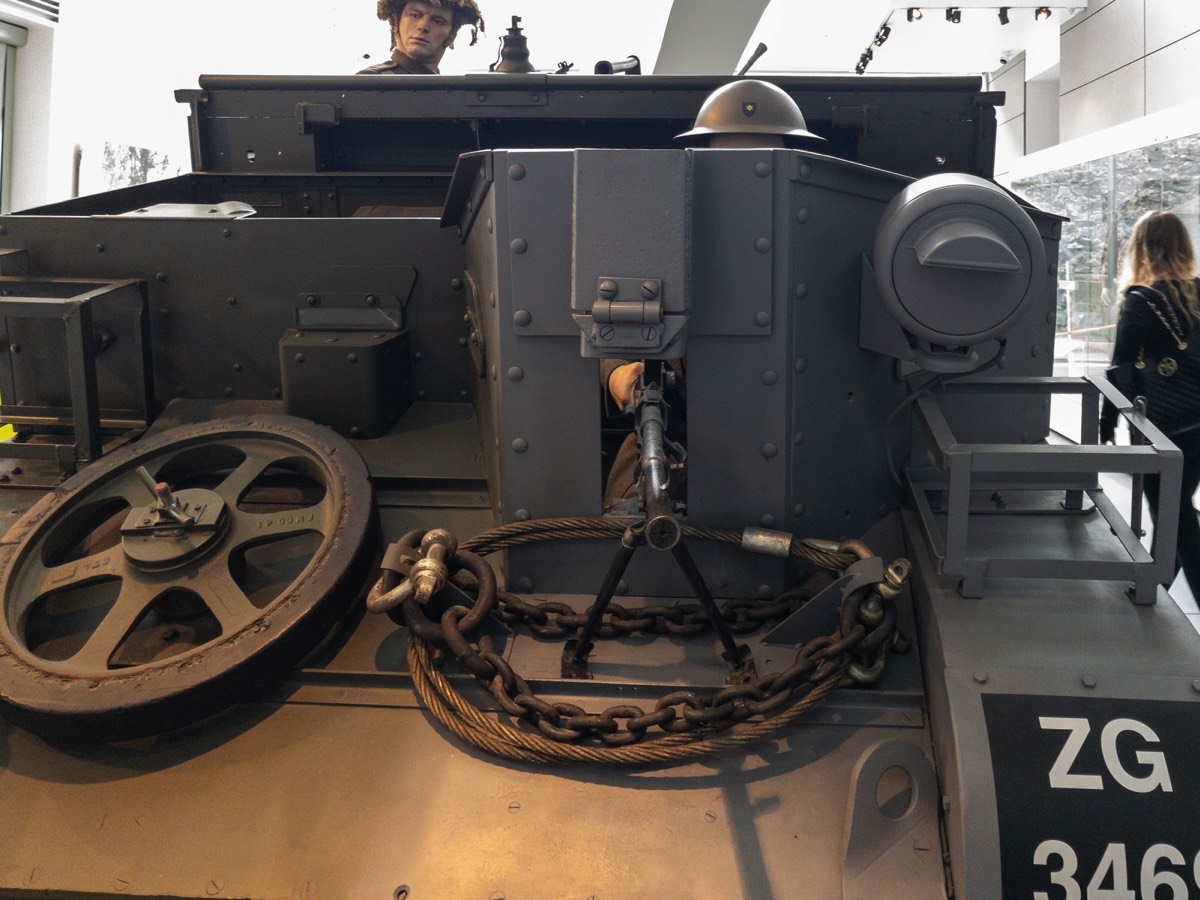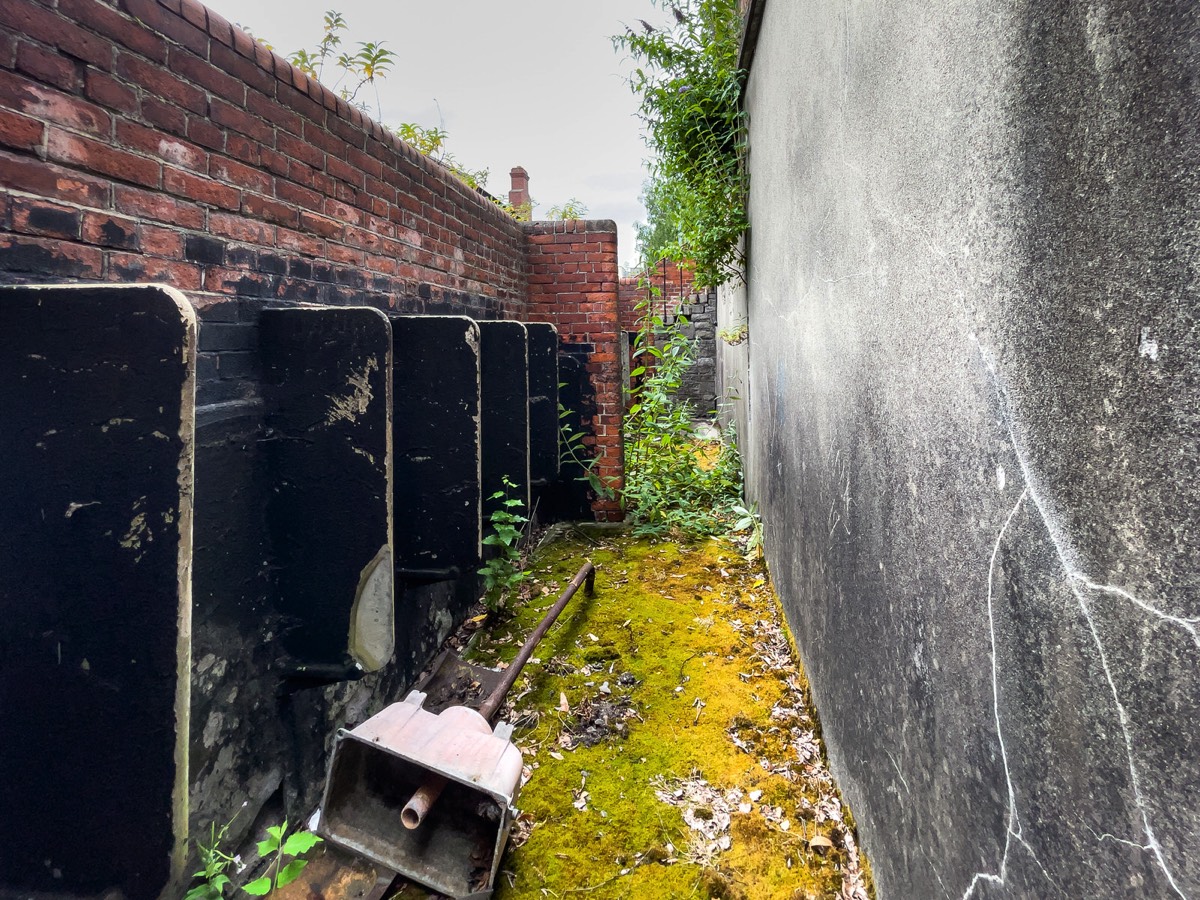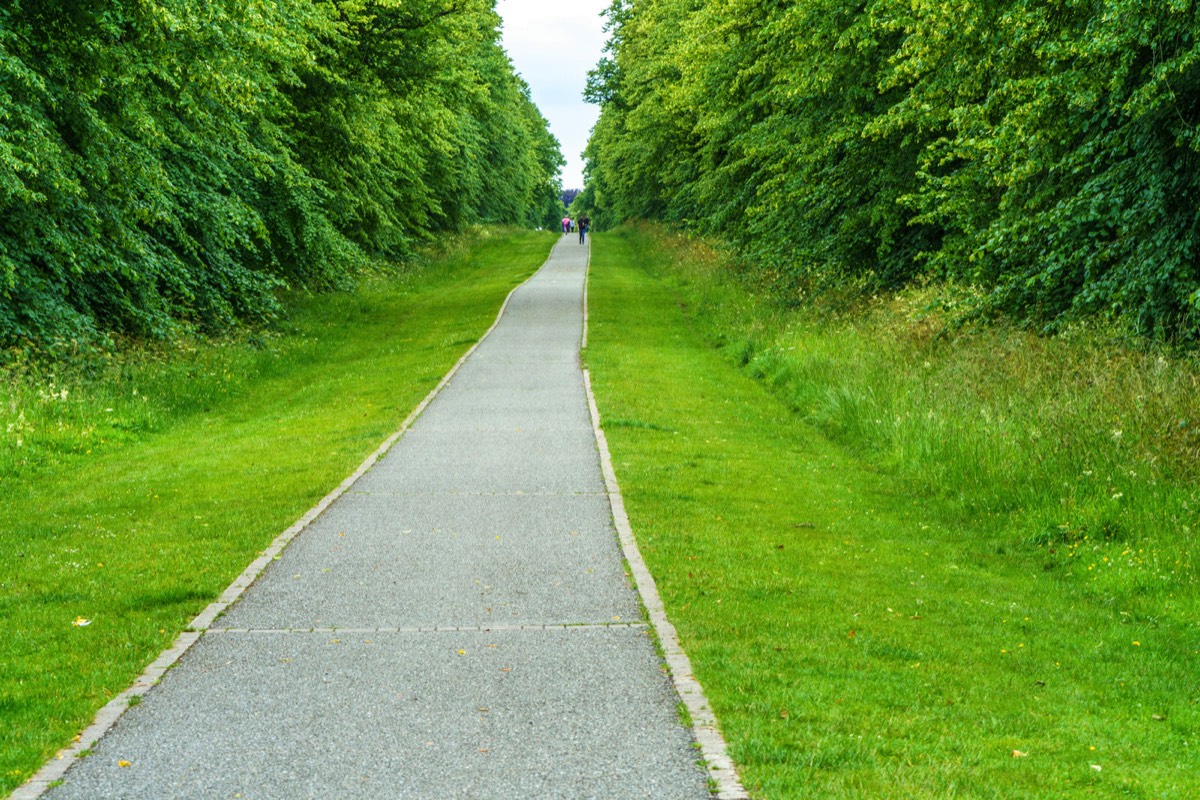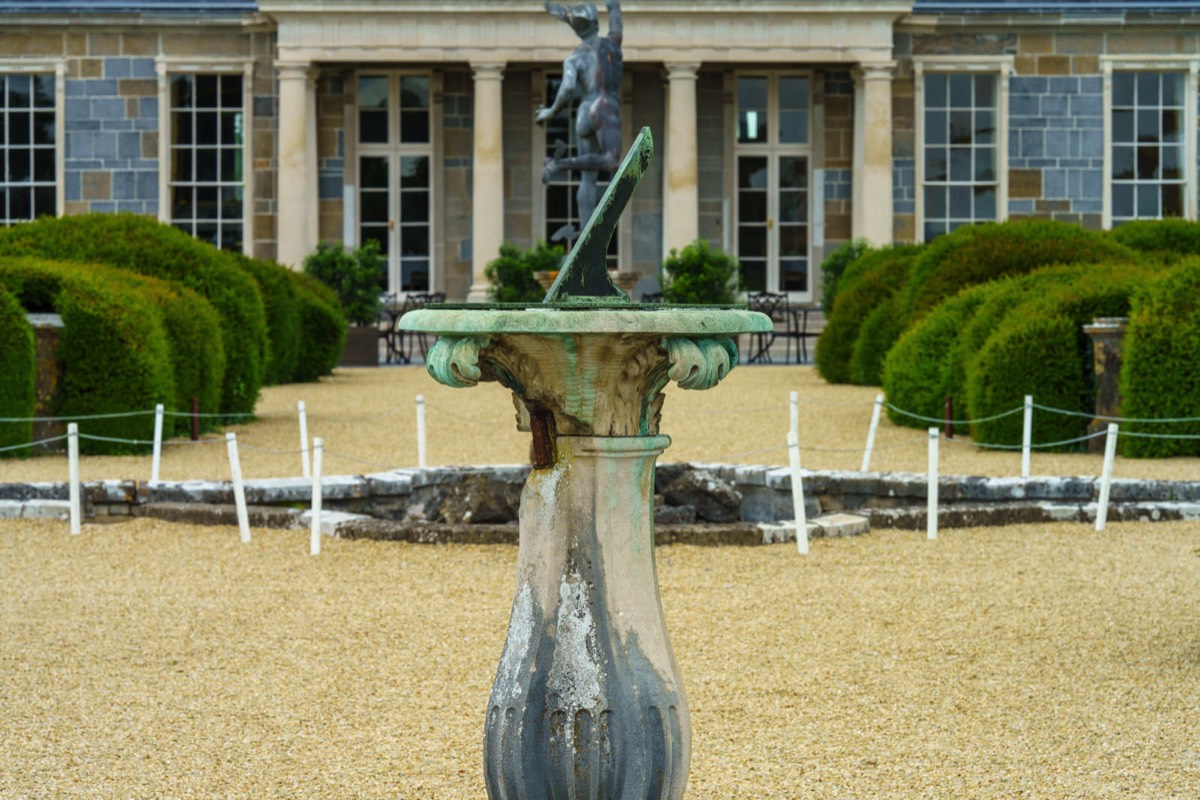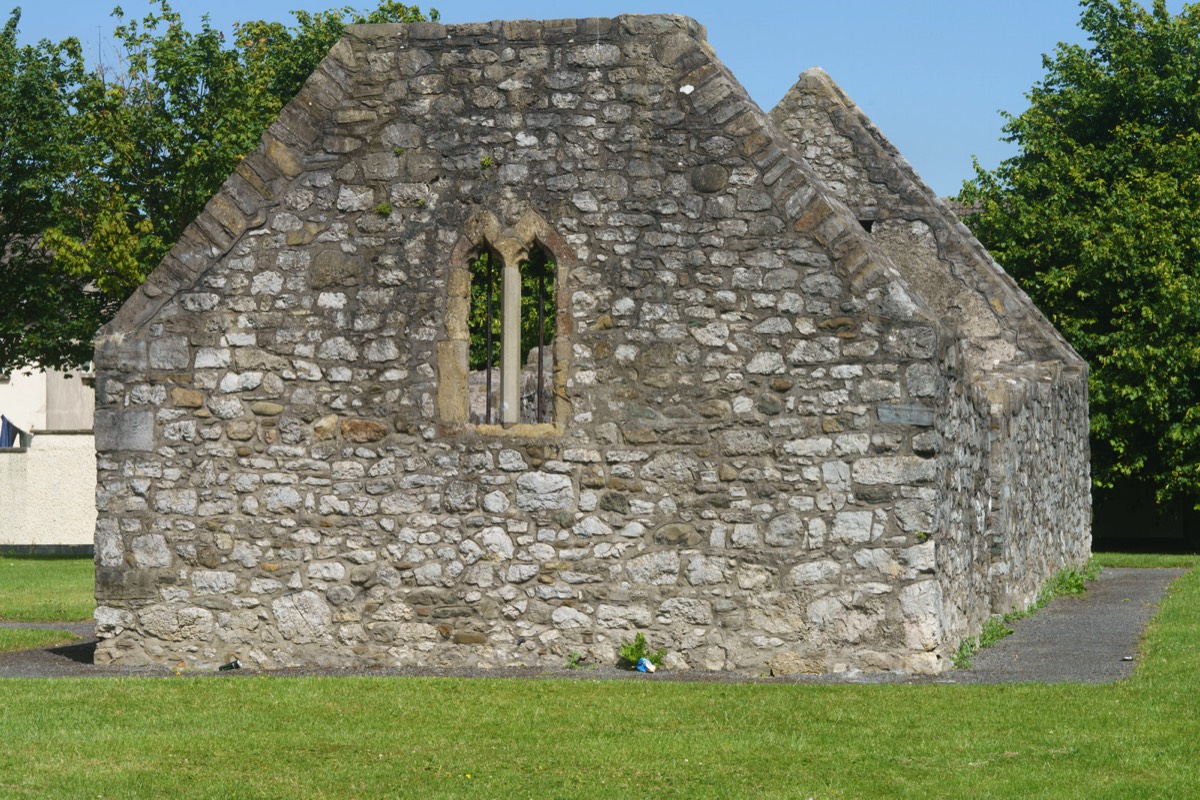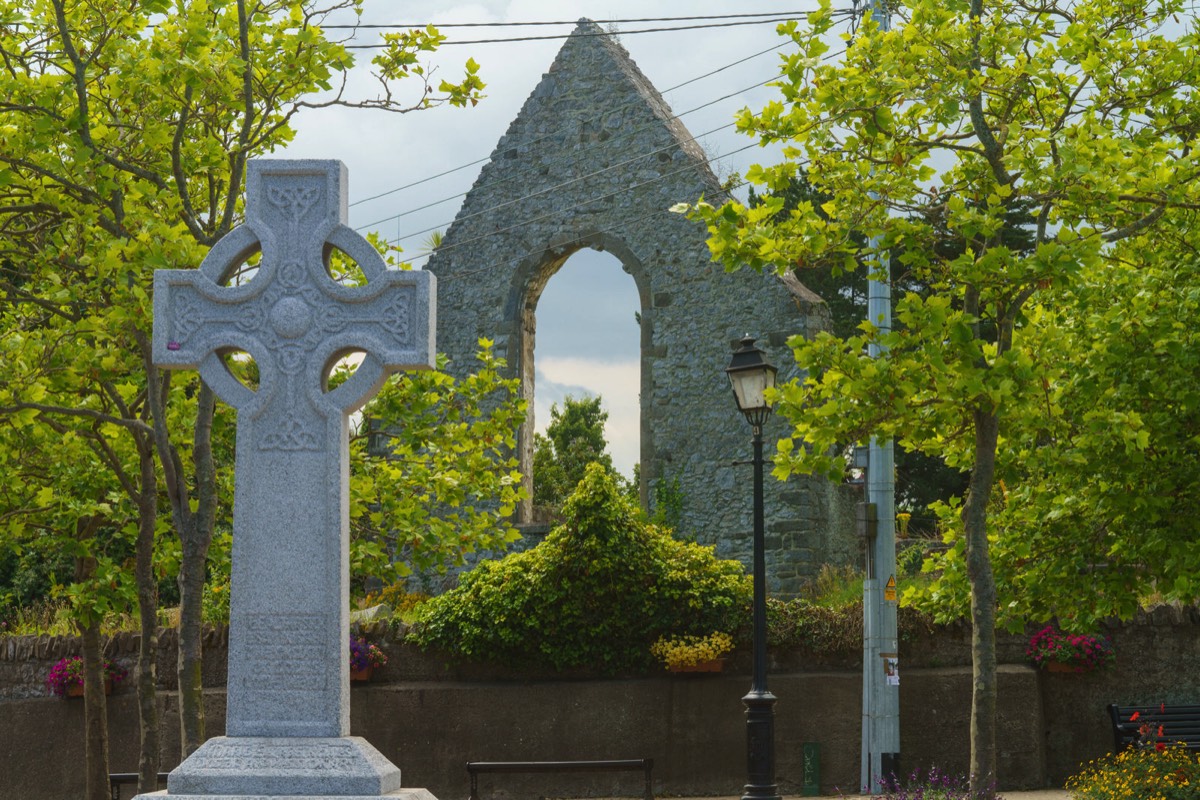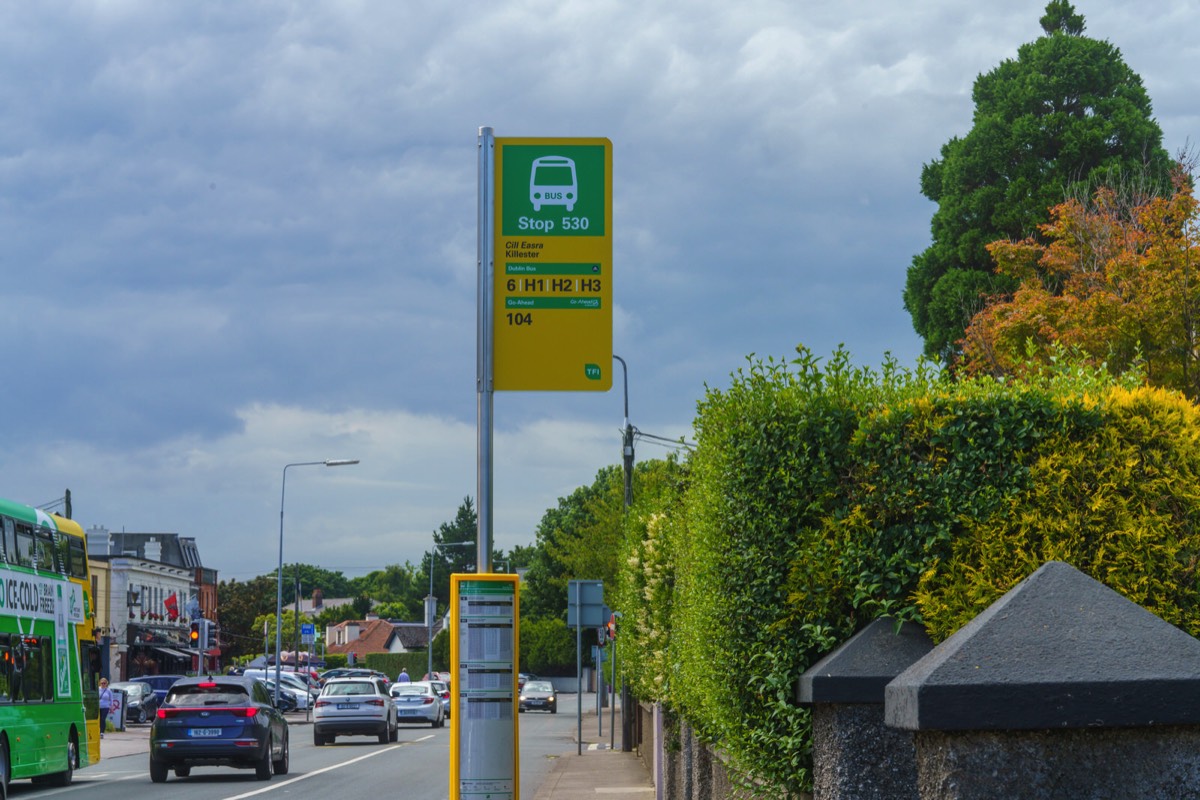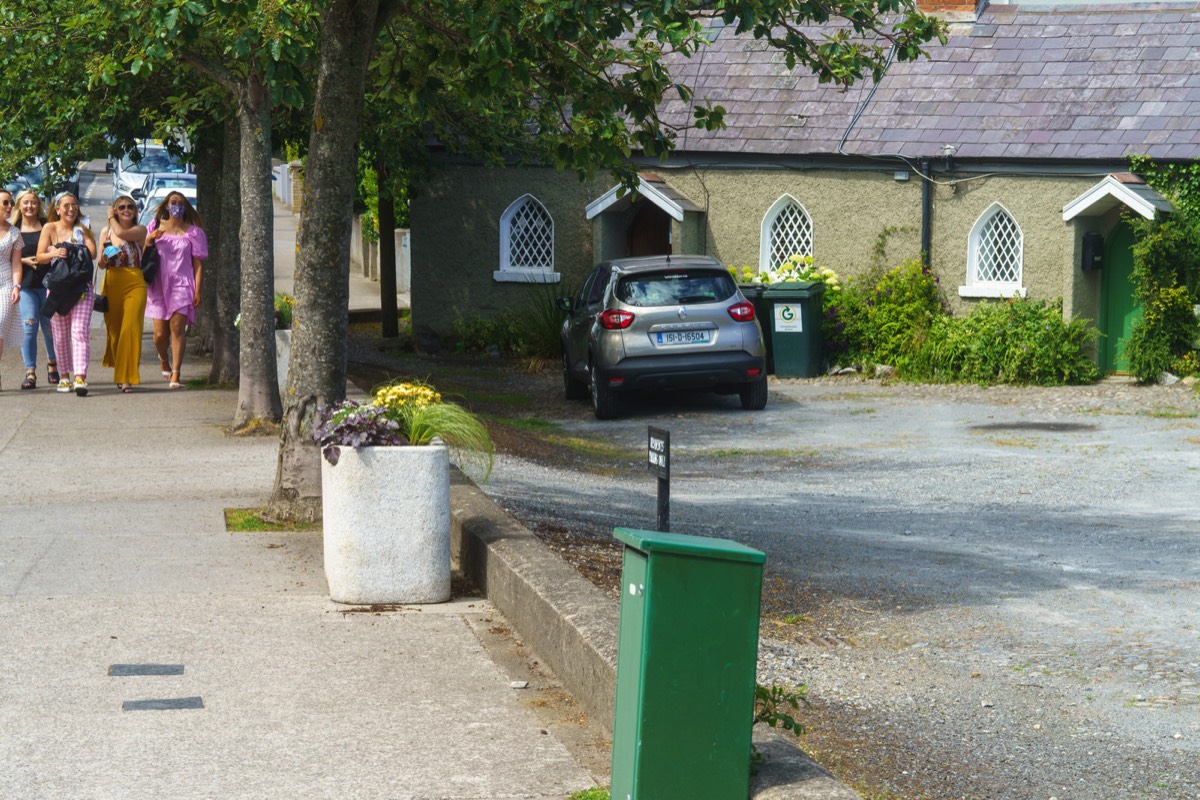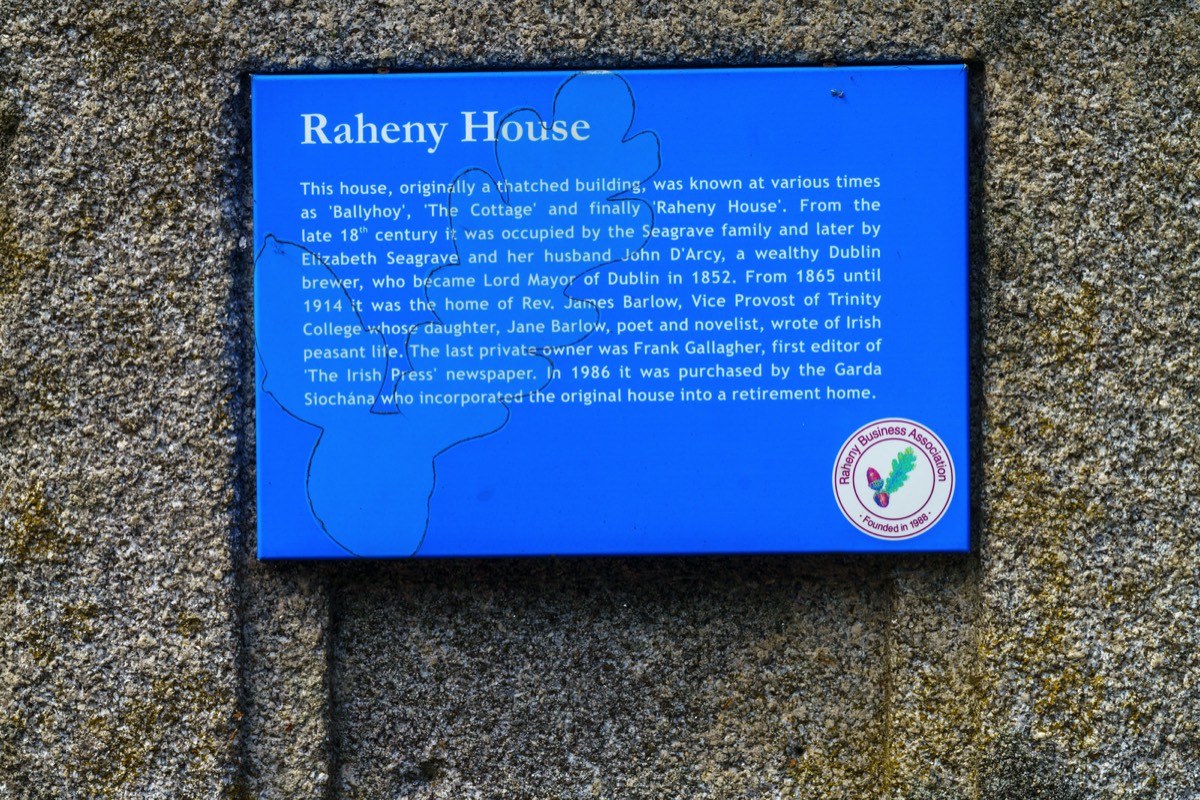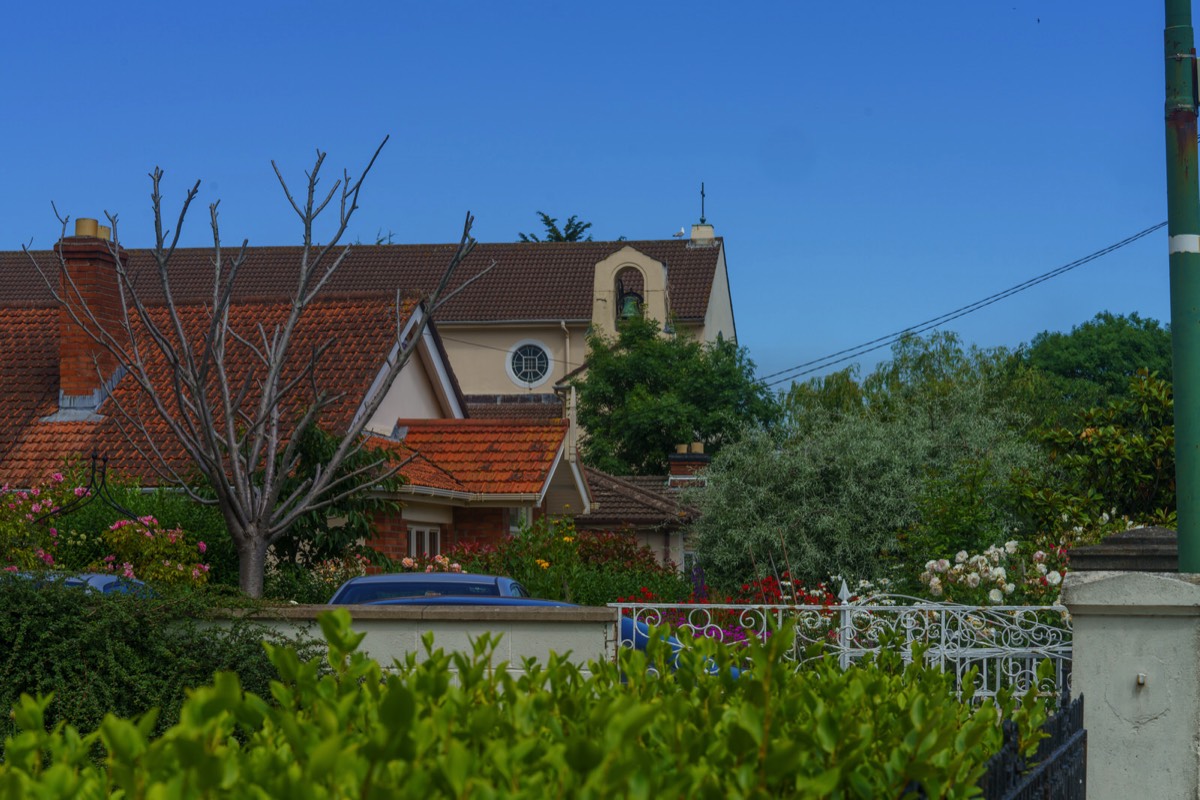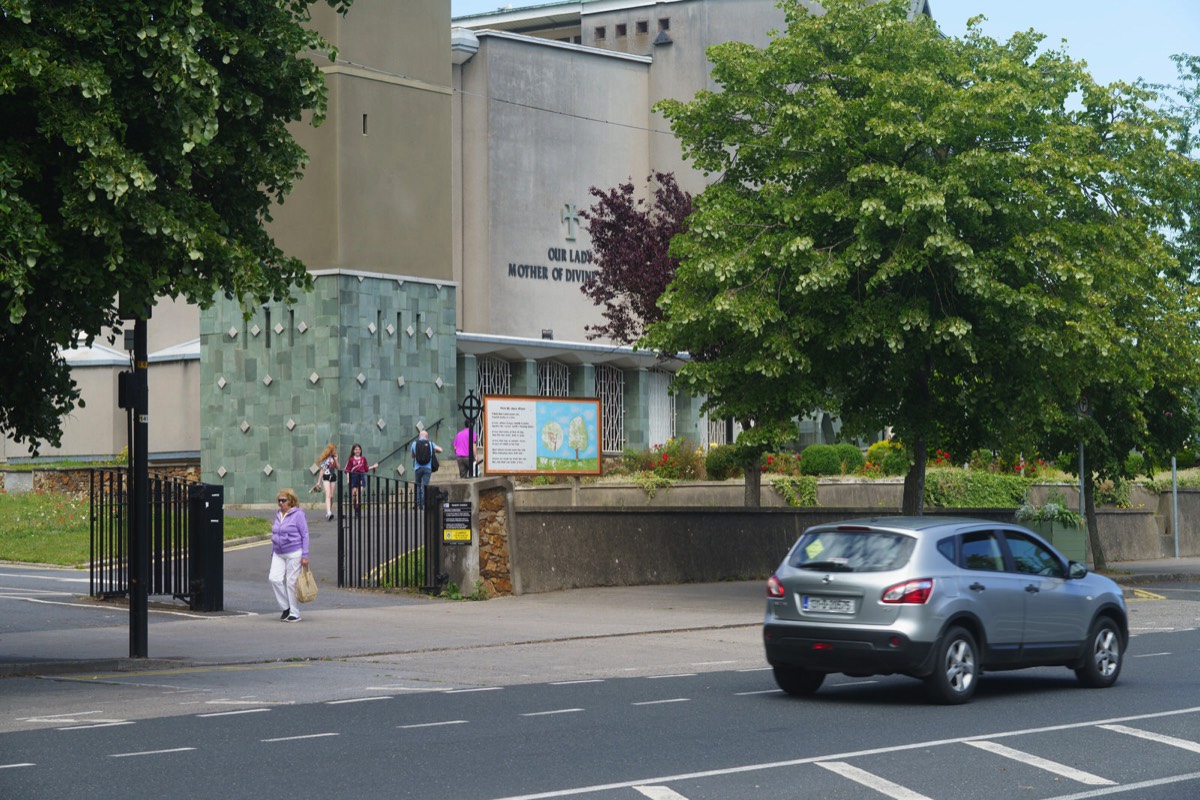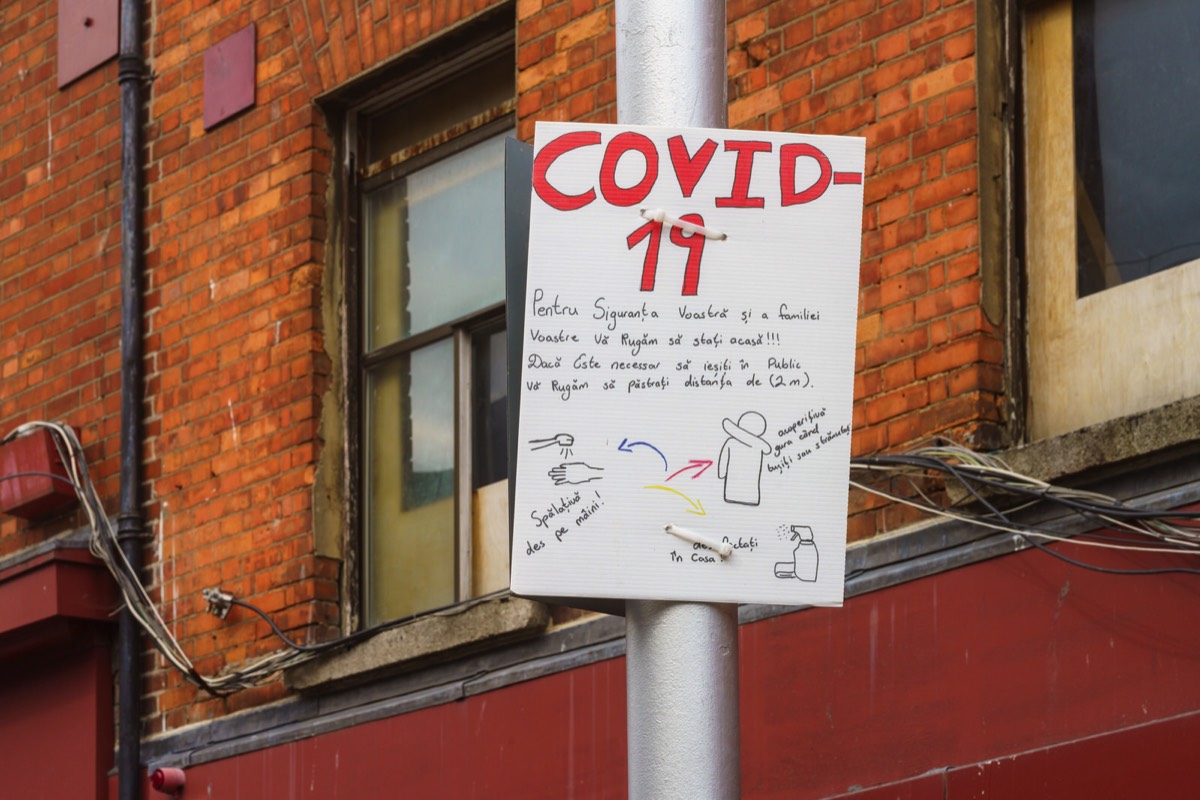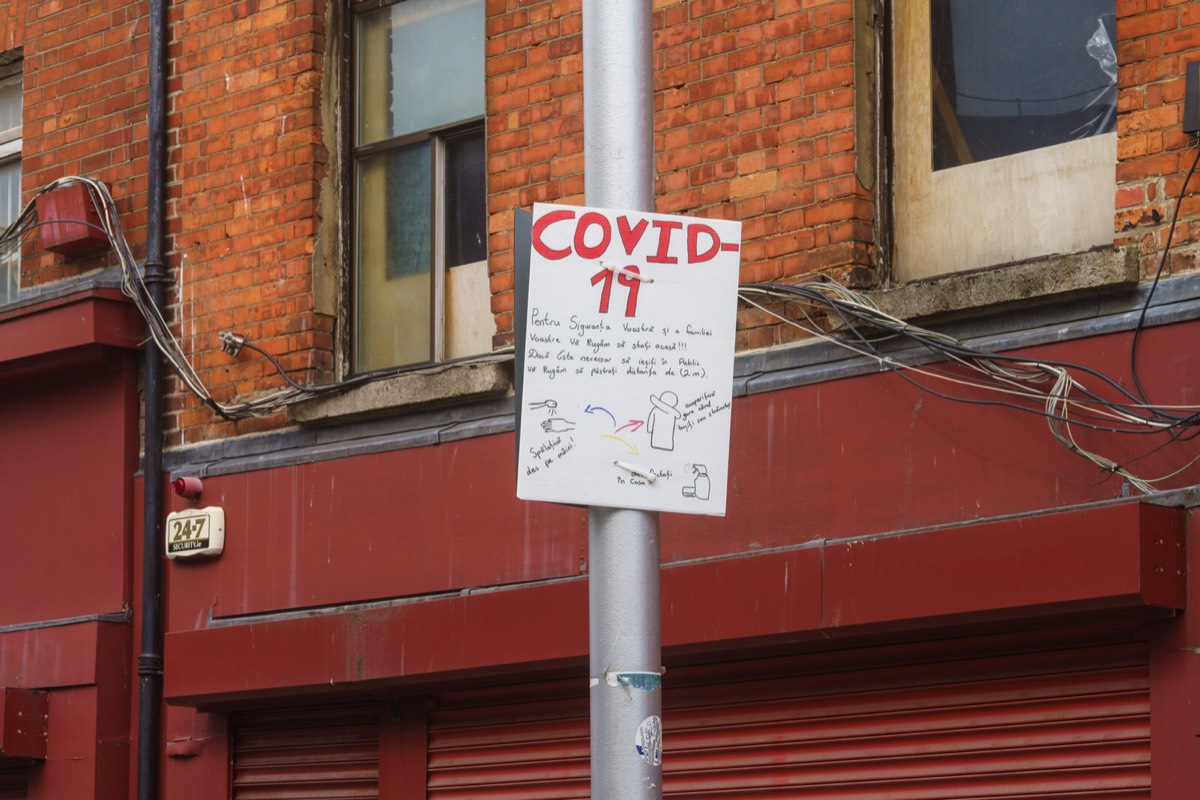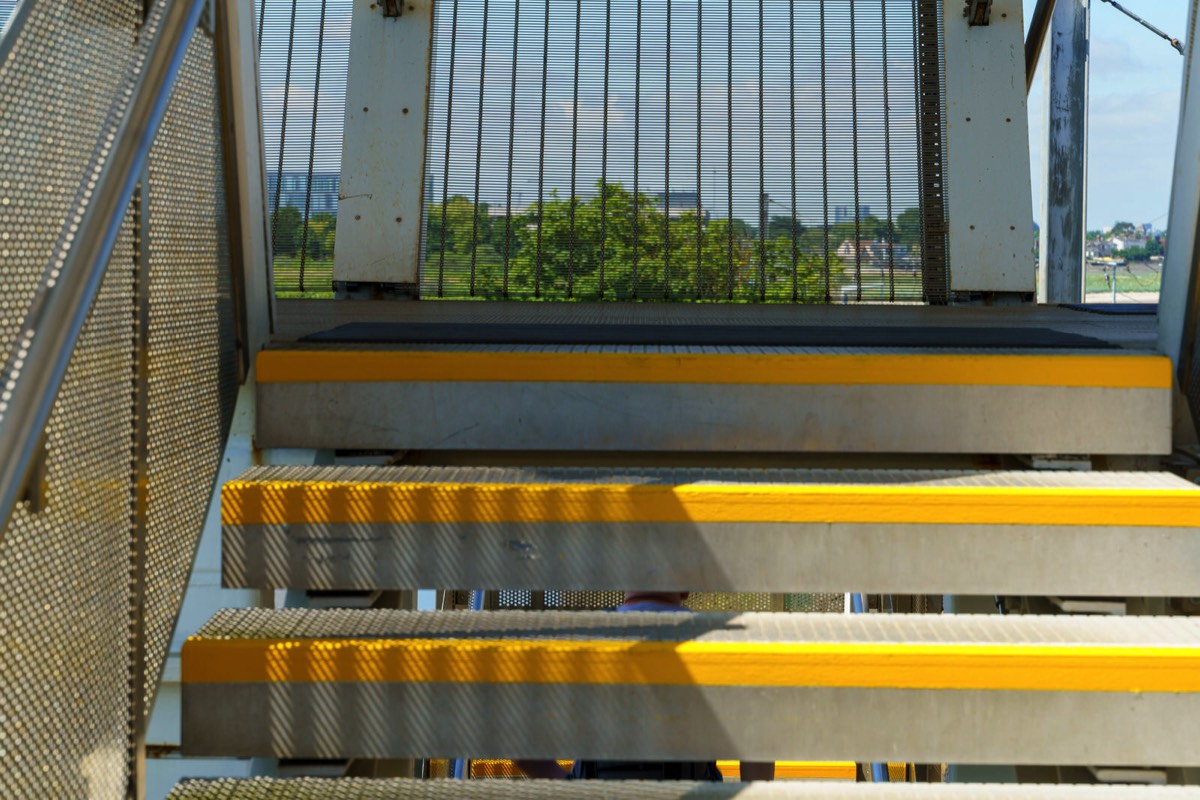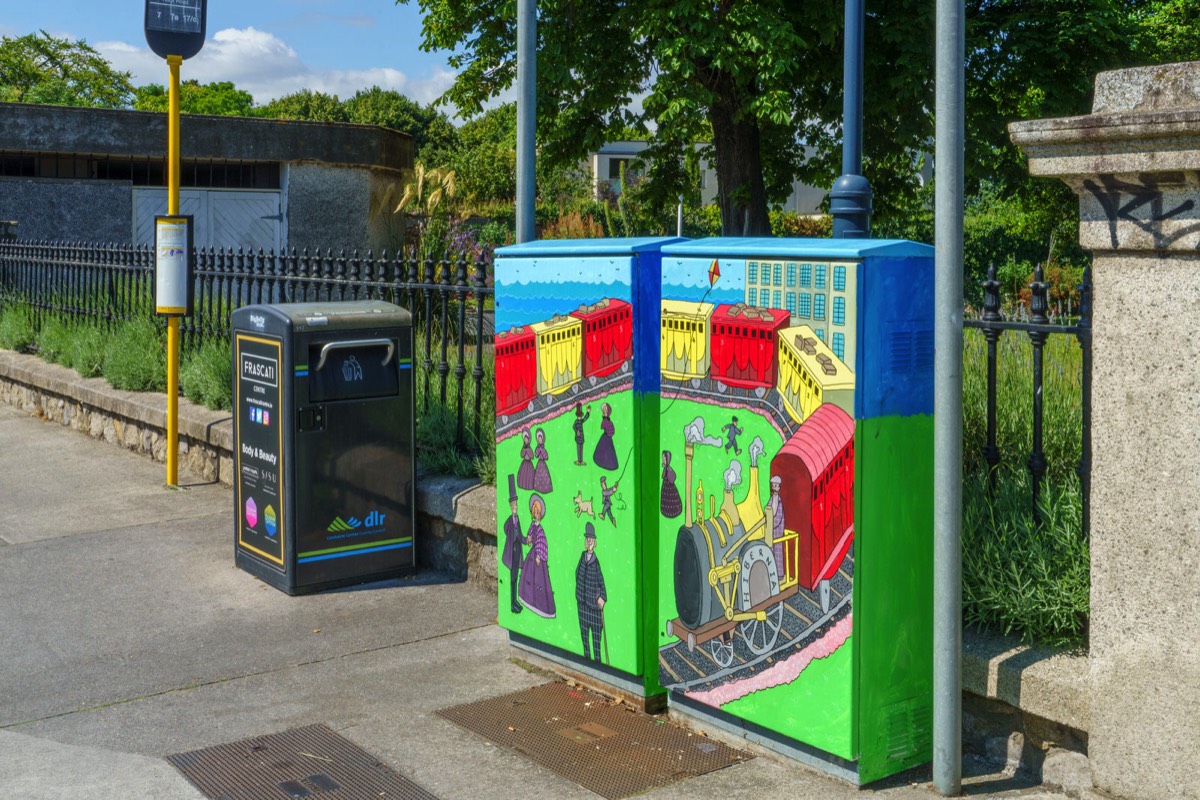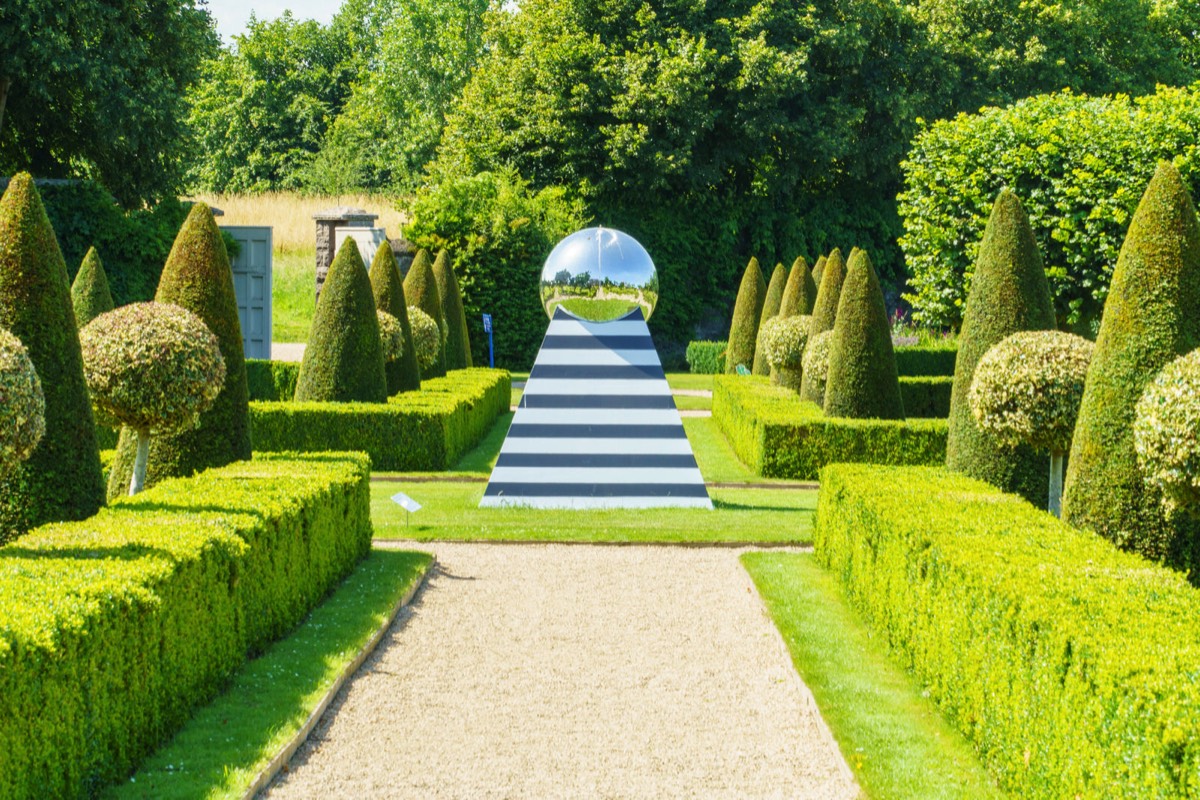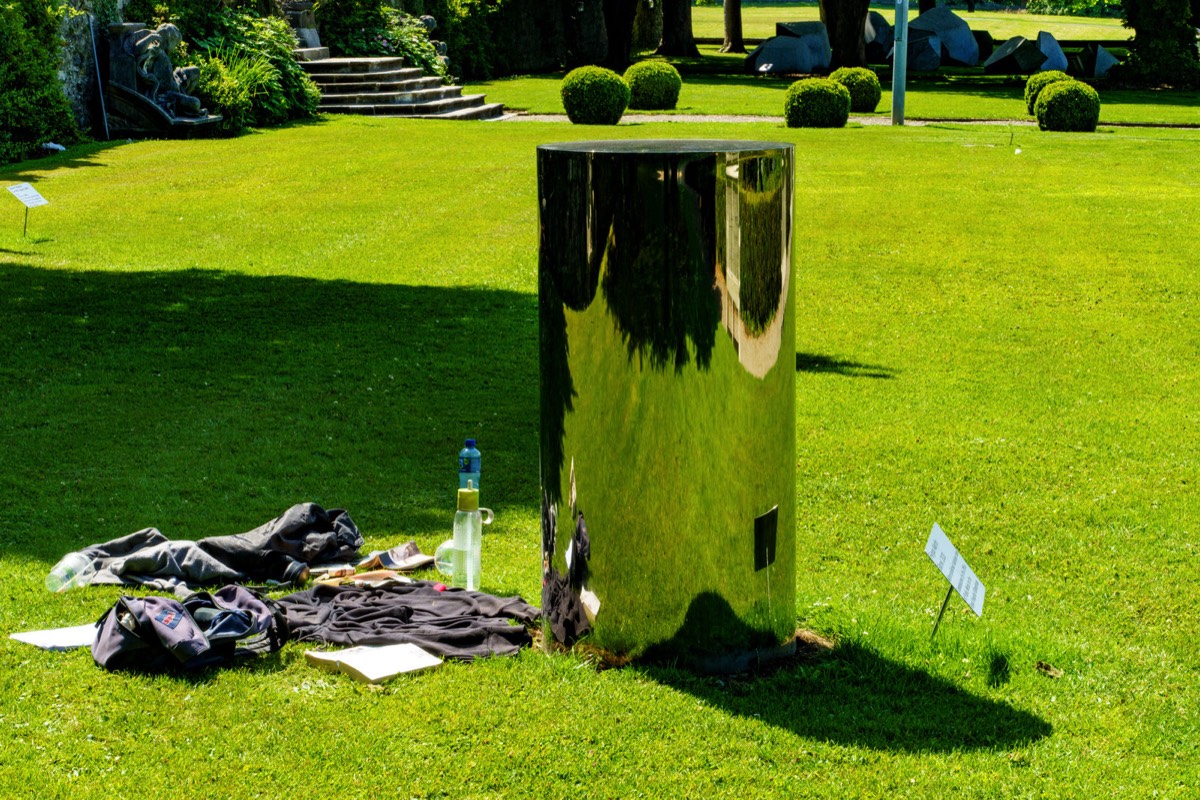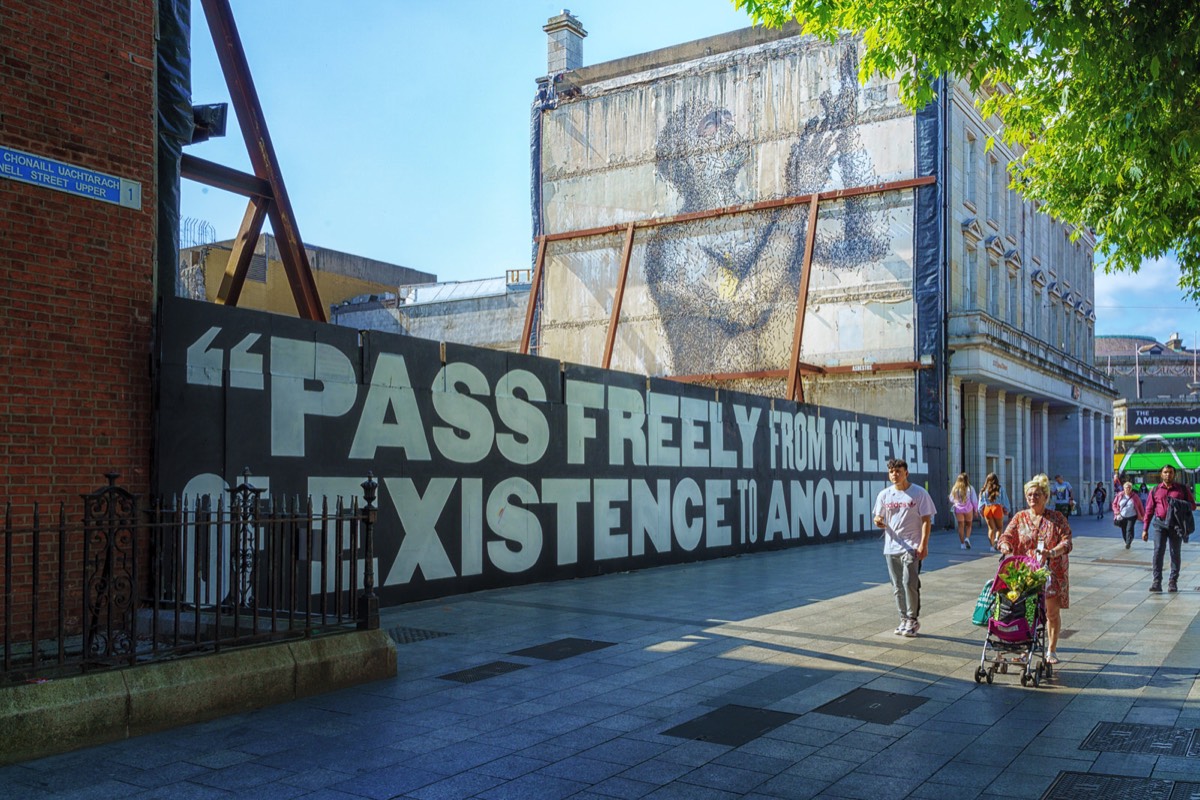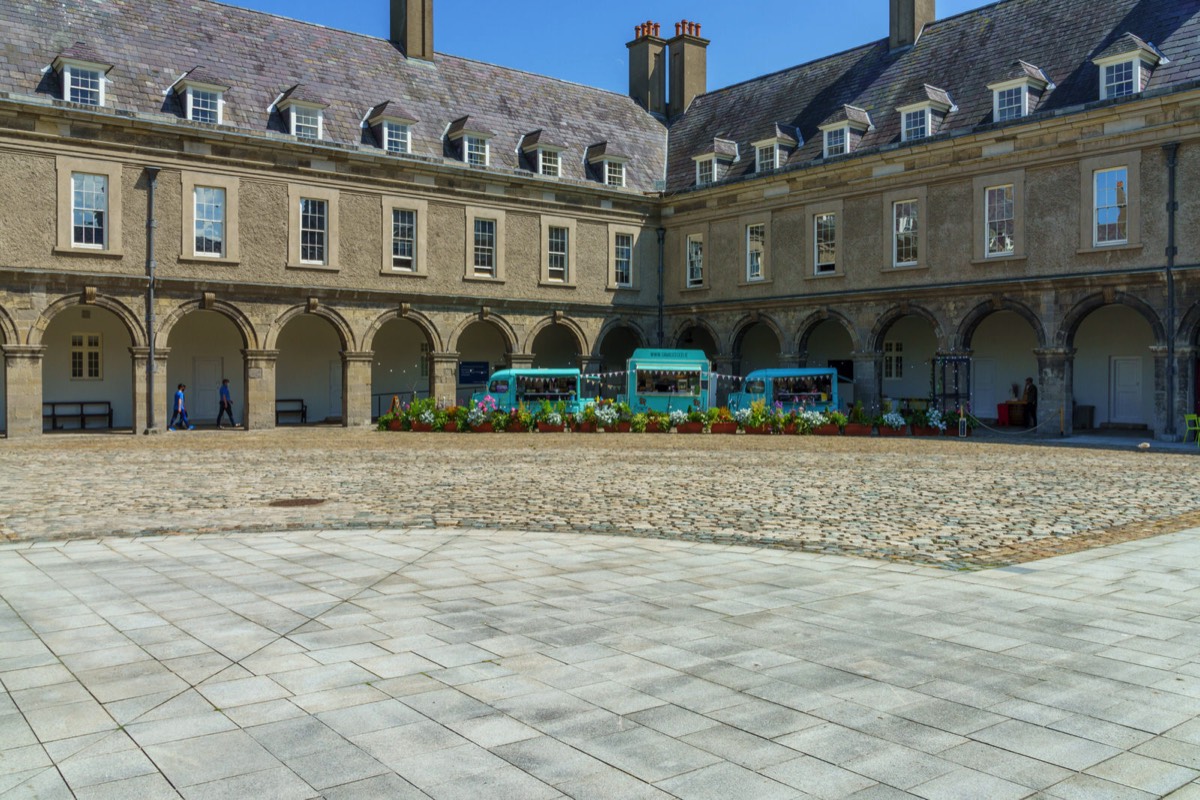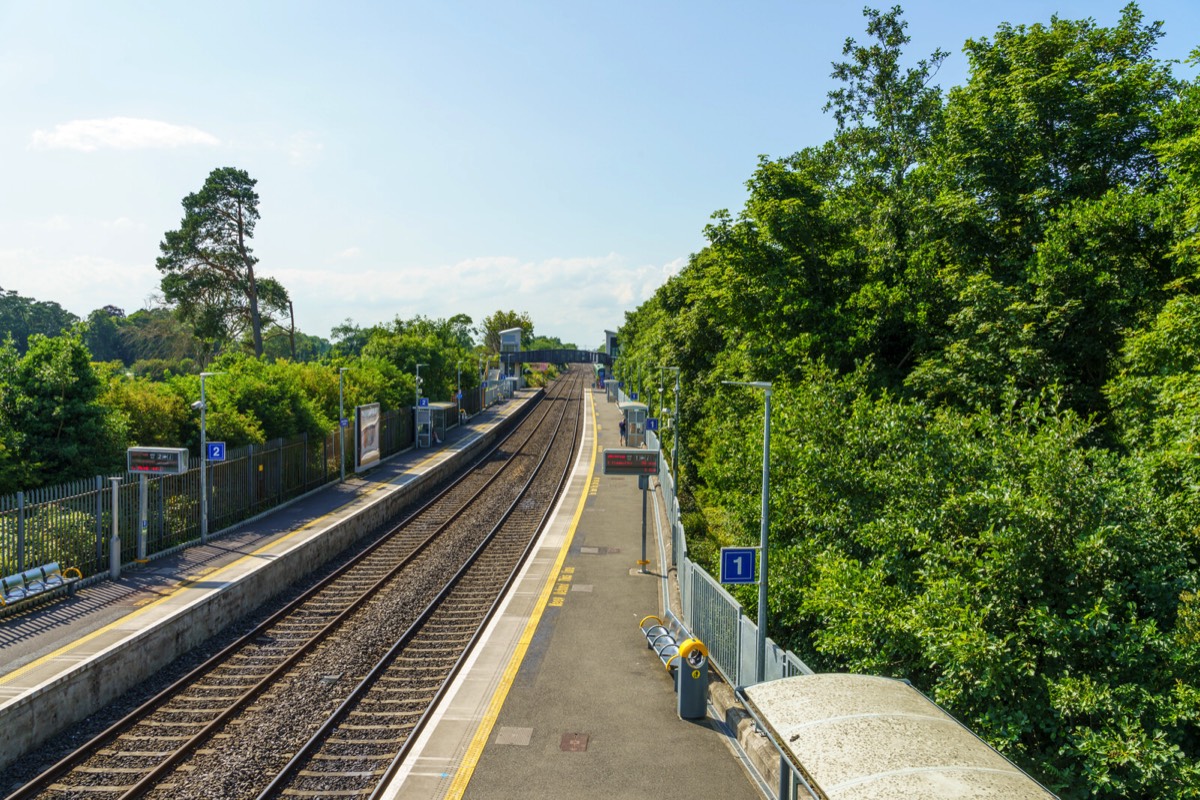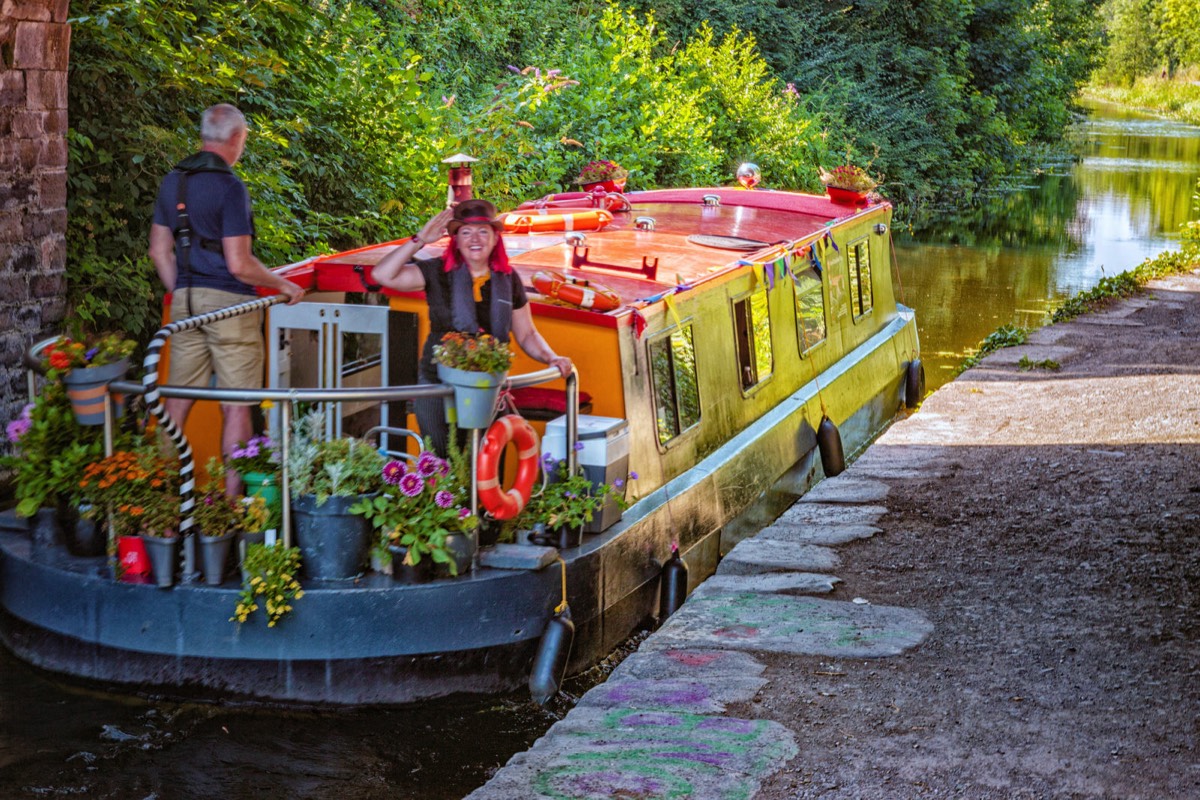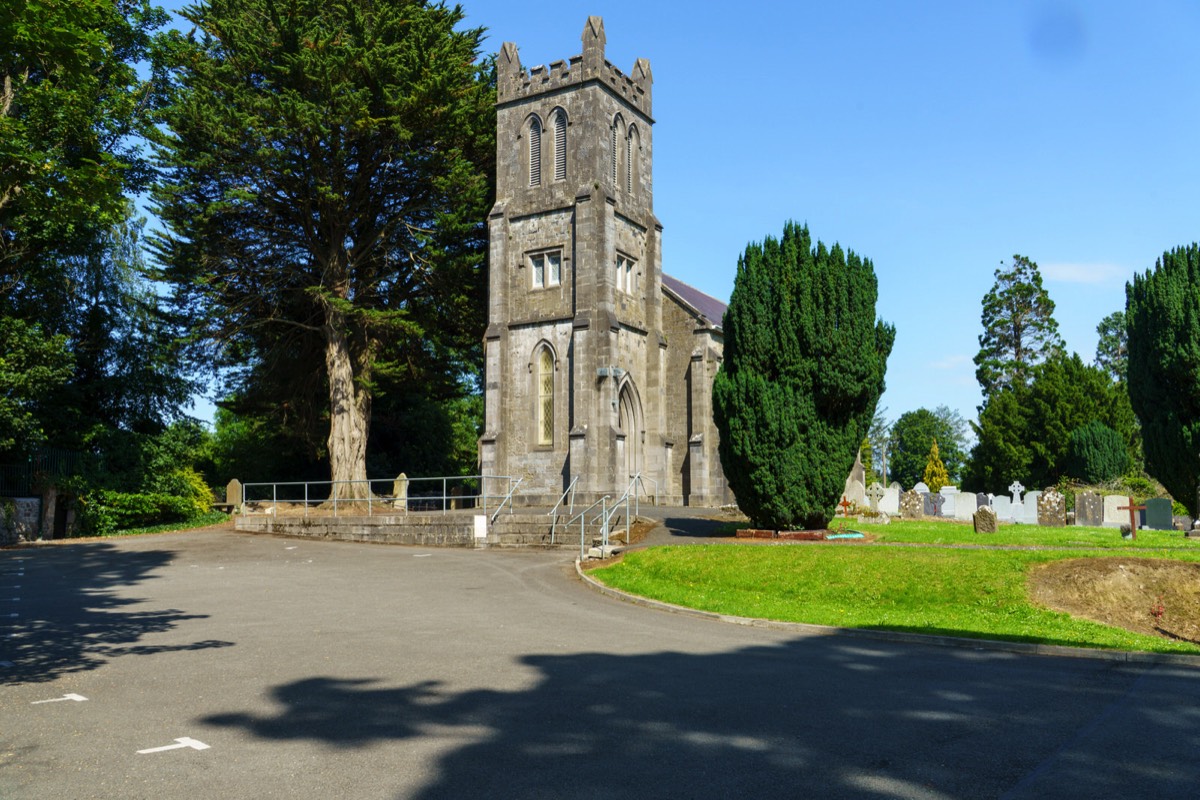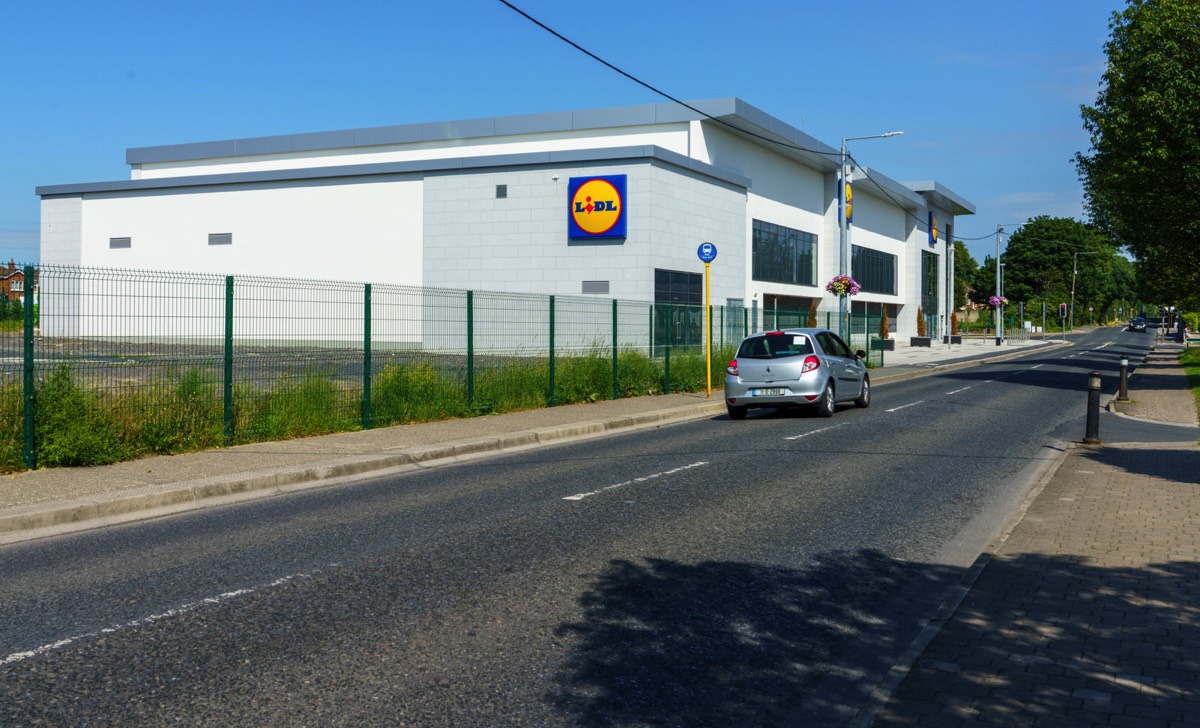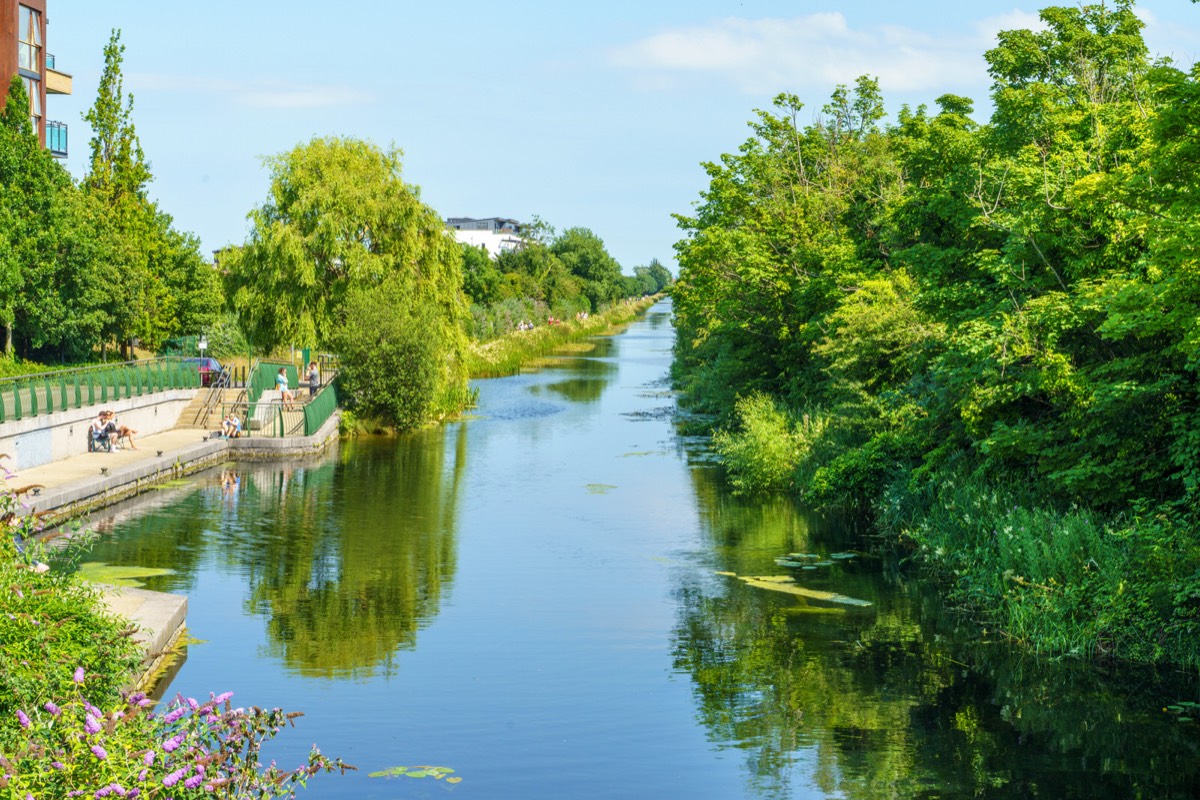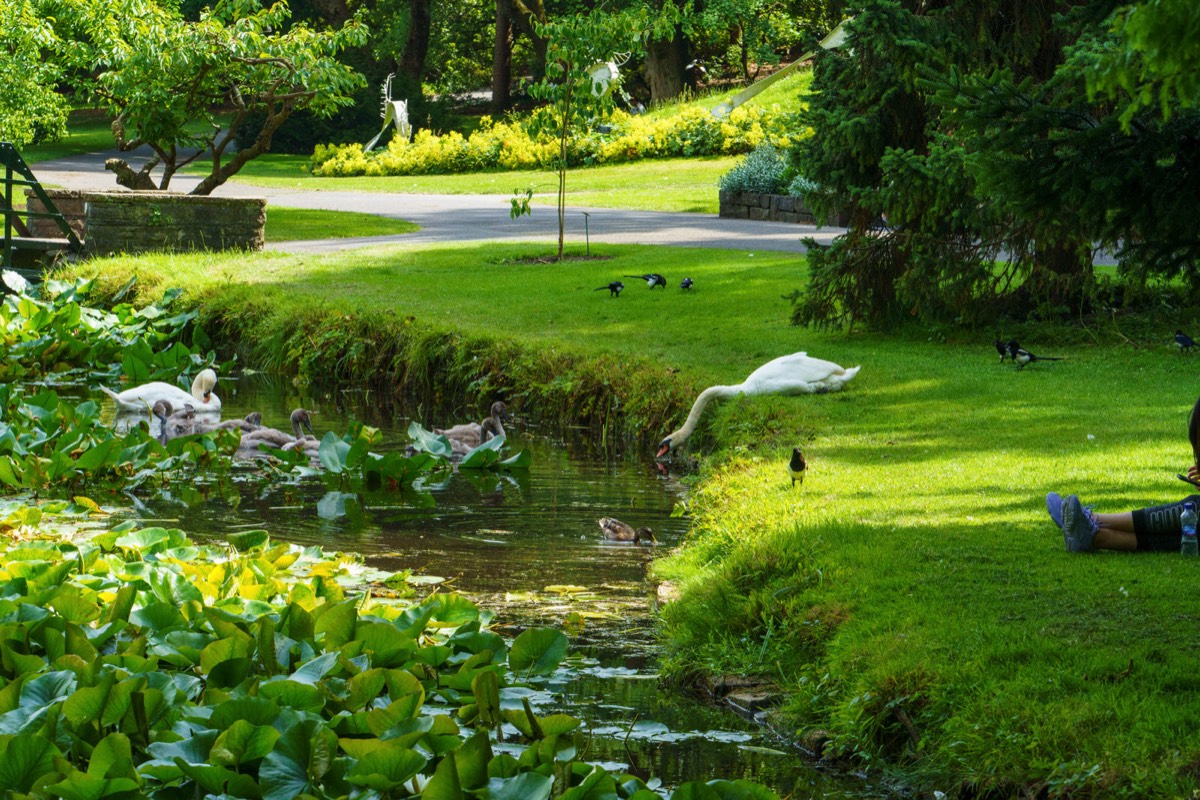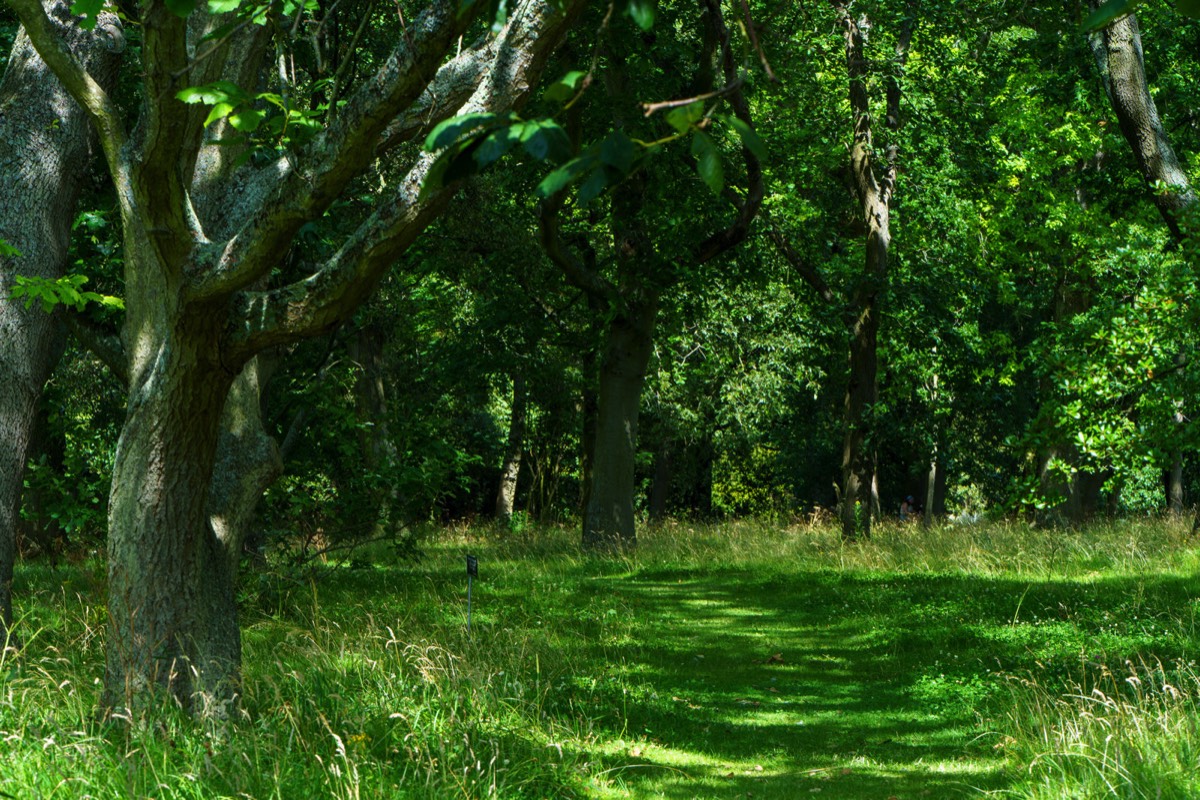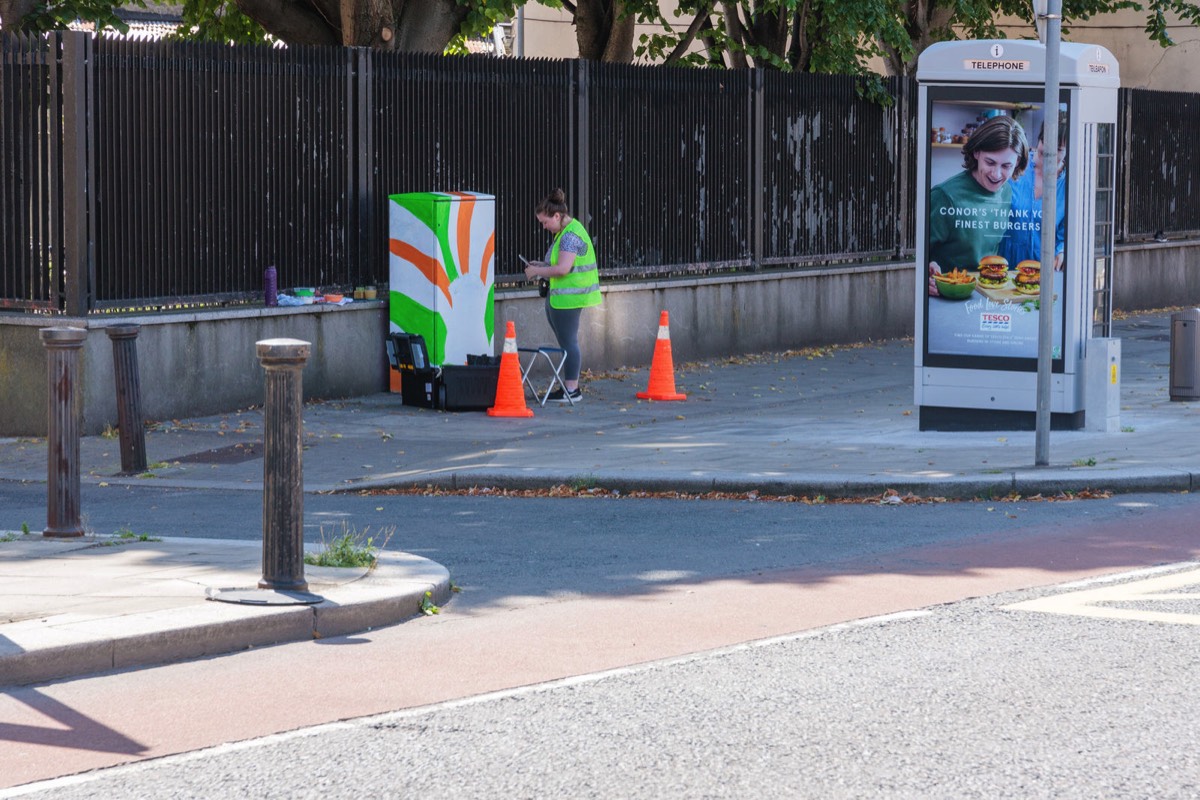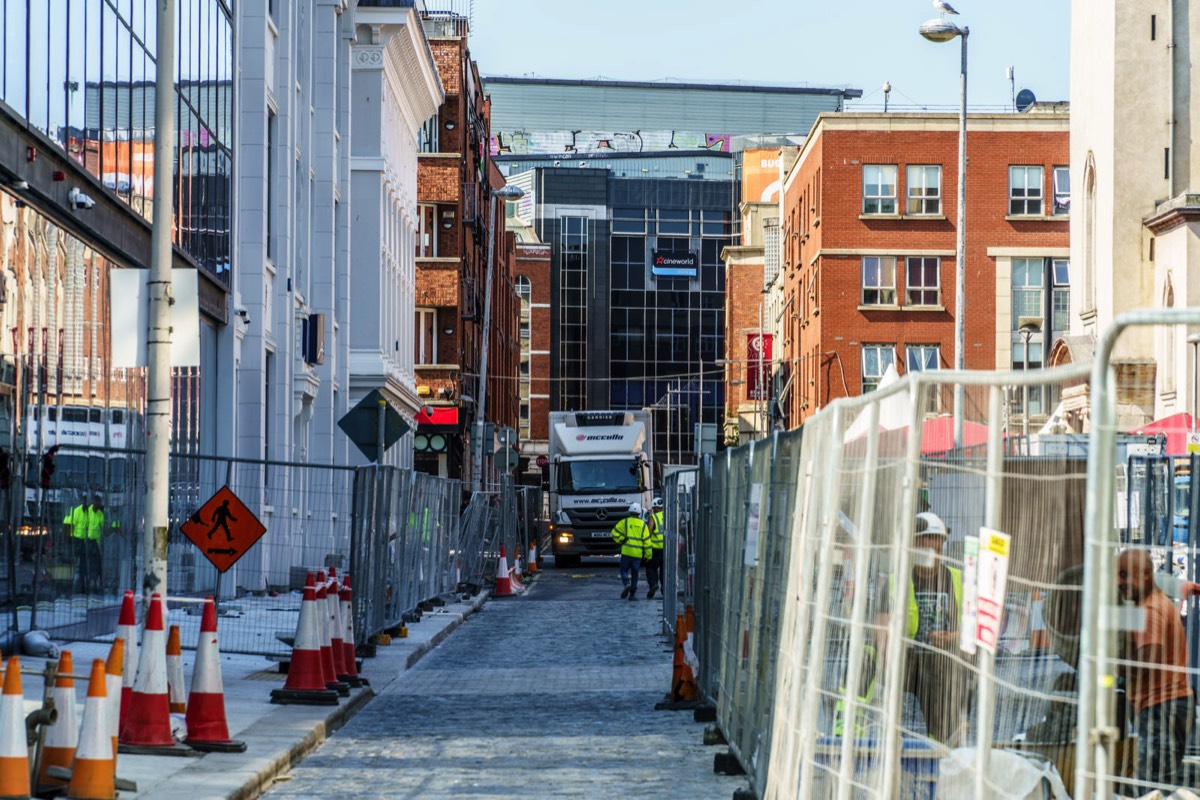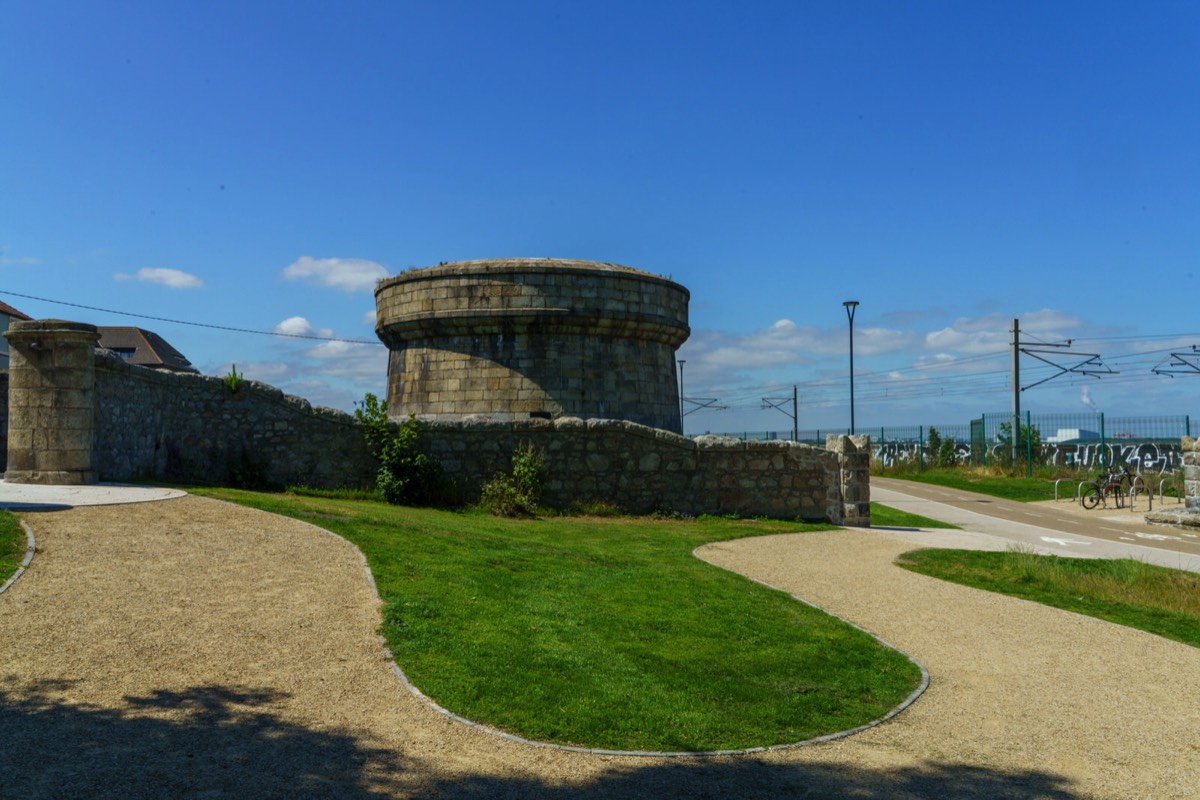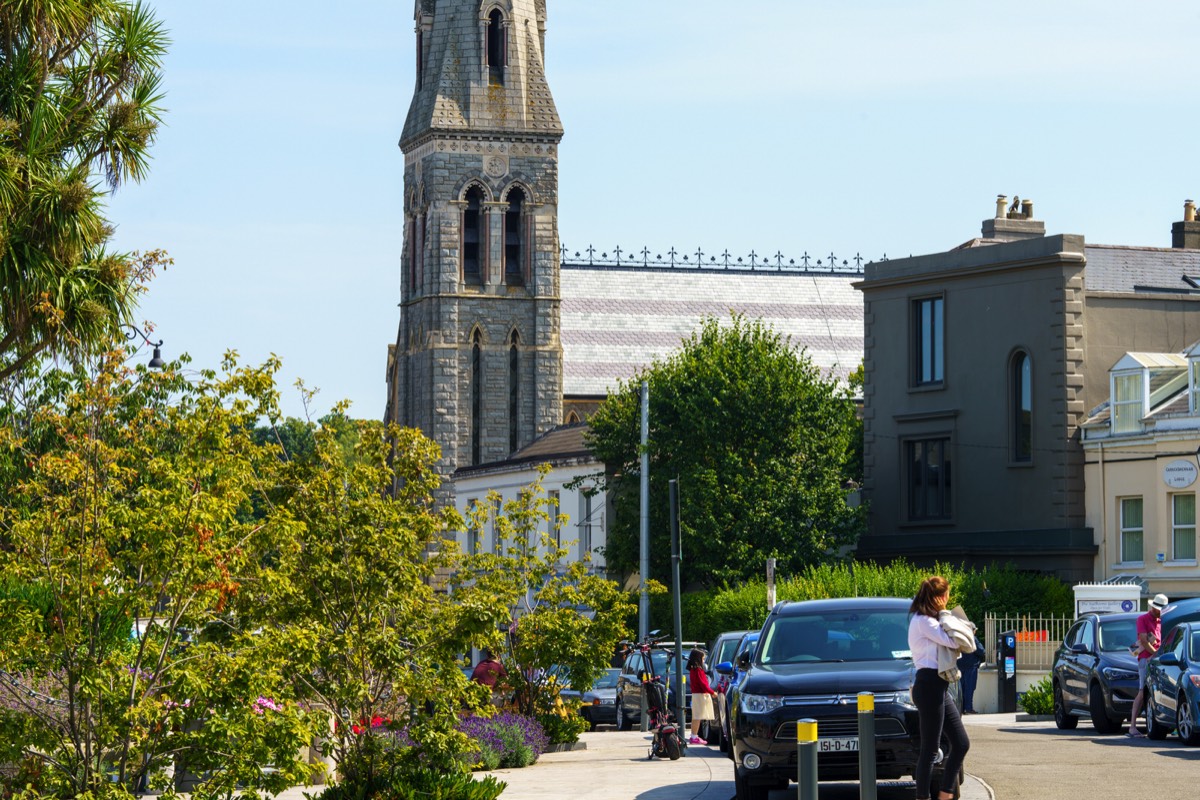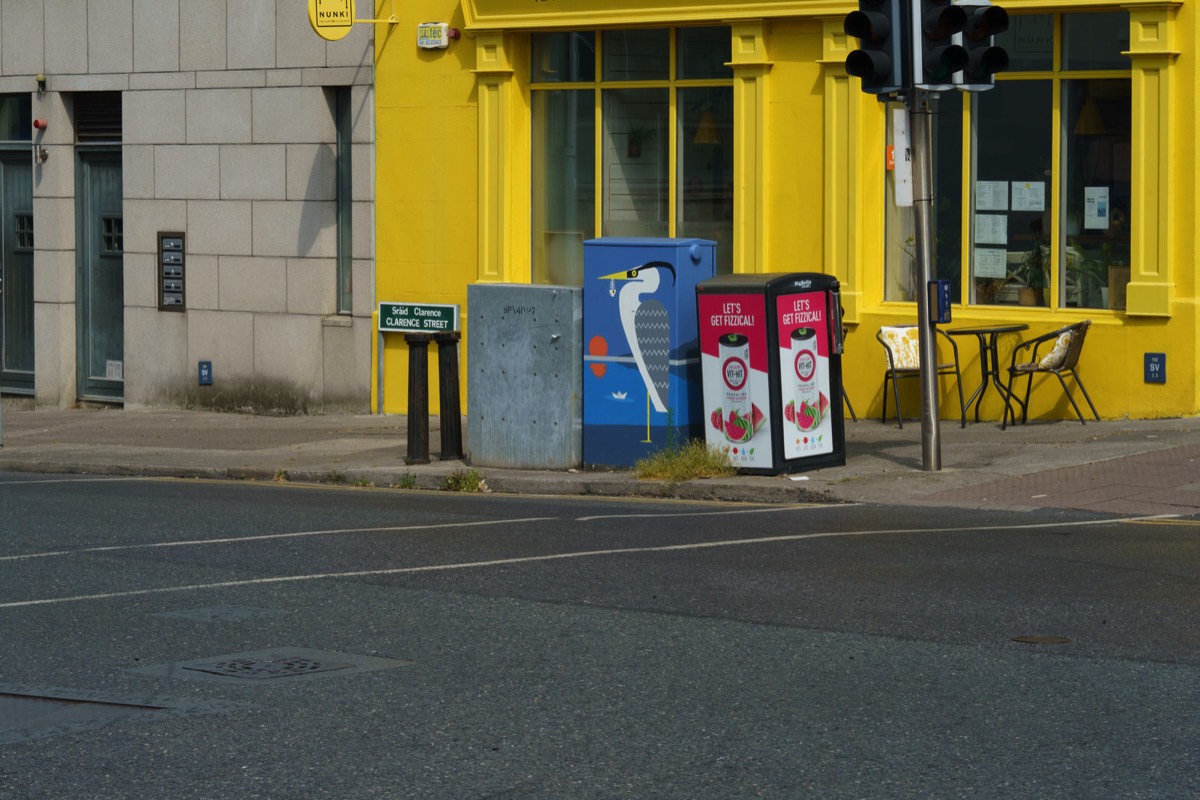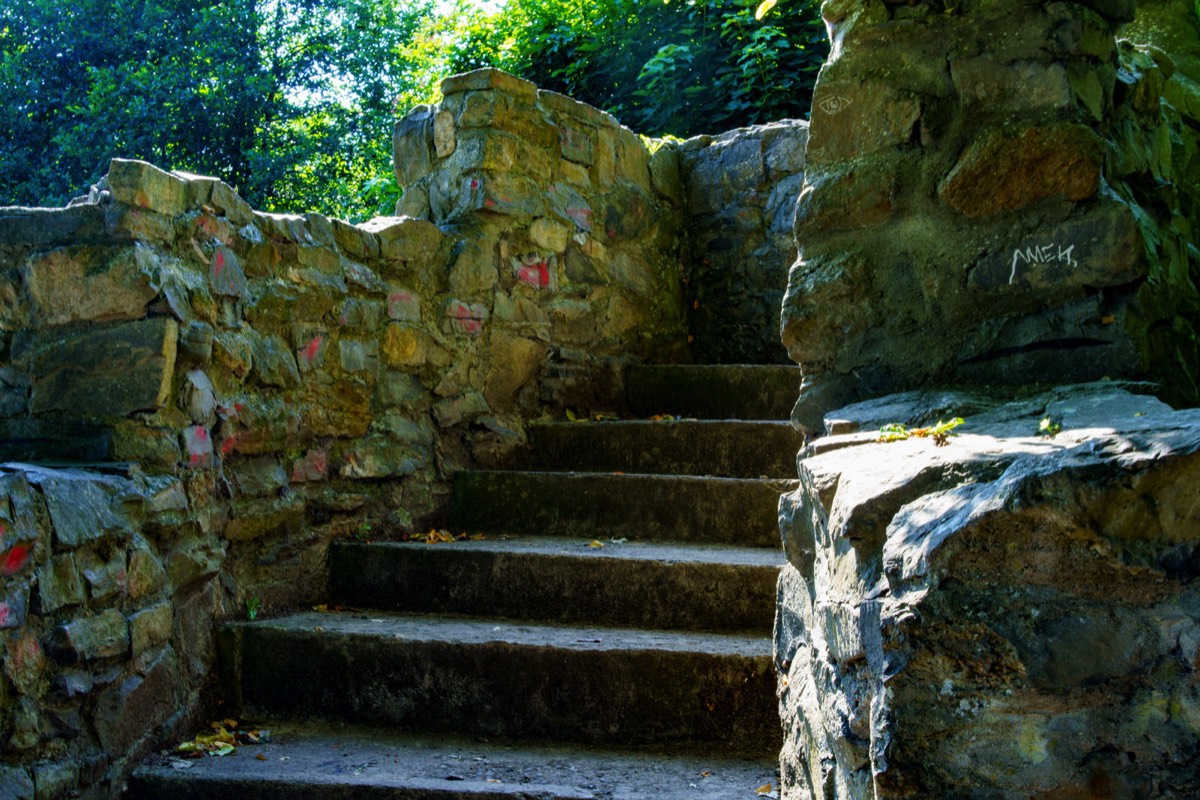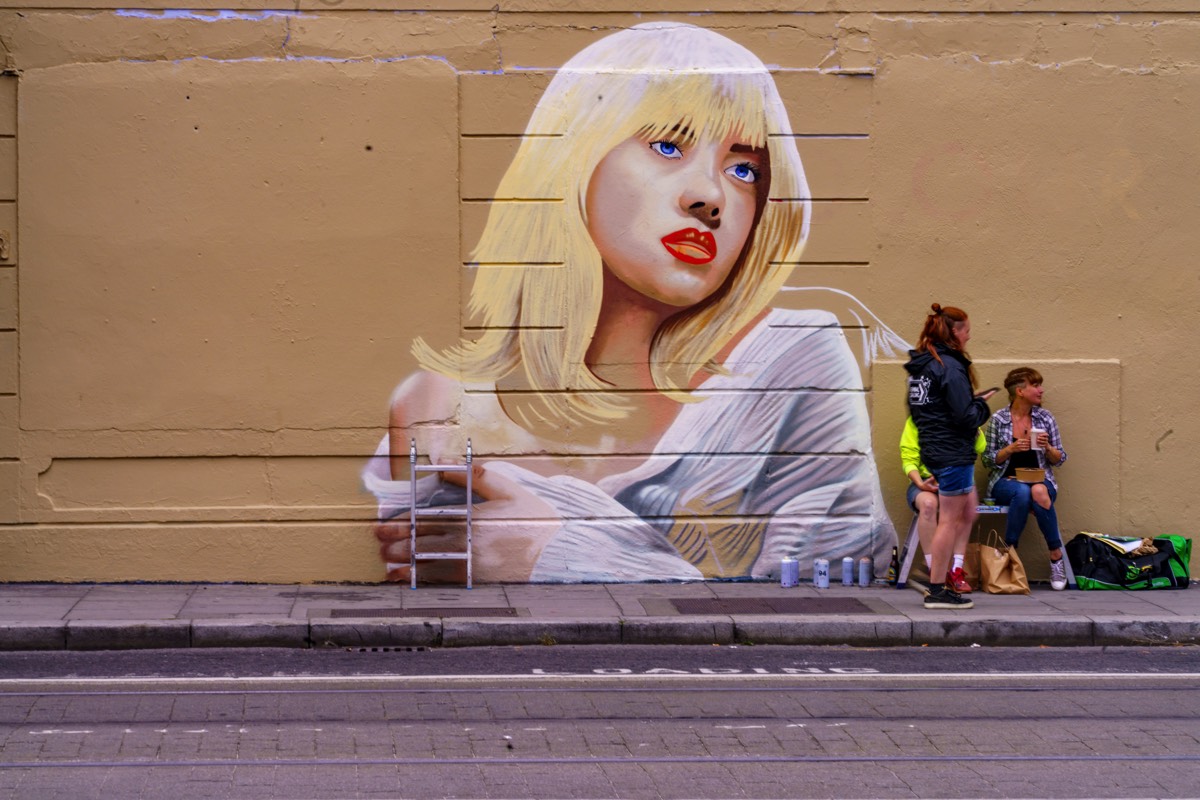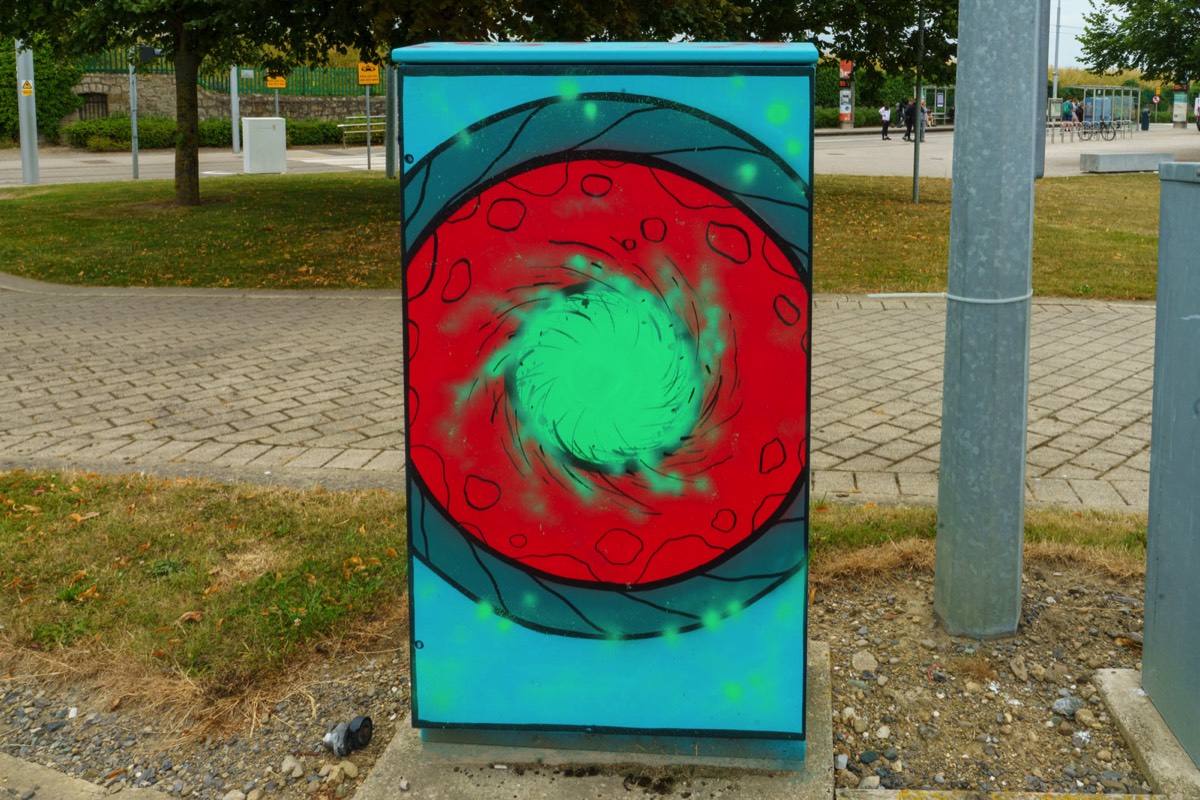JULY 2021 SELECT ANY IMAGE BELOW
The island of Ireland is overloaded with anonymous metal sculptures that I refer to as "red metal yokes". Here in Ireland a yoke is a slang word for a thing - so if someone sees an object that they've never seen before, they might say what's that yoke over there?
Kilkenny is a tourist destination, and its environs include historic buildings such as Kilkenny Castle, St Canice's Cathedral and round tower, Rothe House, Shee Alms House, Black Abbey, St. Mary's Cathedral, Kilkenny Town Hall, St. Francis Abbey, Grace's Castle, and St. John's Priory. Kilkenny is also known for its craft and design workshops, the Watergate Theatre, public gardens and museums. Annual events include Kilkenny Arts Festival, the Cat Laughs comedy festival and music at the Kilkenny Roots Festival.
Malahide railway station opened on 25 May 1844. It is now one of the northern termini of the DART system, (the other being Howth). The station features a heritage garden and an attractive ironwork canopy. The ironwork in the canopy contains the monogram of the Great Northern Railway ('GNR'), who operated the route prior to nationalisation of the railways.
Niall O Neill, the artist responsible, is an established sculptor, living and working in Wicklow. He has built up a reputation and portfolio in the realm of public art with large scale public sculpture located around the island of Ireland.
Malahide has lovely beaches but they are further along the Estuary. Walking from the village along the beach you’ll come to the wide velvet strand along the Mouth of the Estuary, from here the beach leads to Low Rock. Then the beach gets rocky as you approach High Rock. If you continue on you will arrive at Portmarnock beach where the sandy strand opens wide in front of you once more.
This wonderful 268 acre (109 Hectare) park hosts the recently redeveloped Malahide Castle and Gardens offering a fun and informative experience for any visitor.
The sculpture seen in my photographs represents the Talbot family crest. Unfortunately, I do not know the name or the artist or when it was carved.
There are two sailing clubs situated on the estuary; Swords Sailing & Boating Club and Malahide Yacht Club. The inner, Broadmeadow (Bromwell) estuary is also the home of Fingal Sailing School and DMG Sailsports based in the 350-berth marina.
"The View is a coworking space that offers private offices, dedicated desks and flexi desks with exquisite views of the Malahide Marina and Lambay Island."
Abbey Street is located on Dublin's Northside, running from the Customs House and Store Street in the east to Capel Street in the west. The street is served by two Luas light rail stops, one at the Jervis shopping centre and the other near O'Connell Street (Abbey Street Luas stop. About 1 km in length, it is divided into Abbey Street Upper (west end), Middle Abbey Street and Abbey Street Lower (east end).
The Point Depot was a concert and events venue in Dublin.
The building was constructed in 1878 as a train depot to serve the nearby busy port. Among railwaymen it was always known as "The Point Store". In the late 1980s, after many years of neglect and disuse, it was bought by local developer, Harry Crosbie along with Apollo Leisure (now Live Nation) fitted out the venue with balconies, offices and backstage facilities. Before it was renovated, U2 recorded the second track of their 1988 album, Rattle and Hum, "Van Diemen's Land" there, and footage of performances of this song and "Desire" from the building appear in the accompanying Rattle and Hum movie.
The building was constructed in 1878 as a train depot to serve the nearby busy port. Among railwaymen it was always known as "The Point Store". In the late 1980s, after many years of neglect and disuse, it was bought by local developer, Harry Crosbie along with Apollo Leisure (now Live Nation) fitted out the venue with balconies, offices and backstage facilities. Before it was renovated, U2 recorded the second track of their 1988 album, Rattle and Hum, "Van Diemen's Land" there, and footage of performances of this song and "Desire" from the building appear in the accompanying Rattle and Hum movie.
Bollards have closed the road near the roundabout junction with Sean Moore Road and the Toll Bridge Road only allowing access cyclists and pedestrians since August 2020. The closure of Pigeon House Road in Ringsend to motor traffic is to continue for a year following a successful trial.
Ringsend is a southside inner suburb of Dublin, Ireland. It is located on the south bank of the River Liffey and east of the River Dodder, about two kilometres east of the city centre. It is the southern terminus of the East Link Toll Bridge. Areas included in Ringsend are the south side of the Dublin Docklands, and at the west end is the area of South Lotts and part of the Grand Canal Dock area. Neighbouring areas include Irishtown, Sandymount and the Beggars Bush part of Ballsbridge to the south, and the city centre to the west. A key feature of the area is the chimneys of Poolbeg power station.
Irishtown is an inner suburb of Dublin, Ireland. It is situated on the Southside of the River Liffey, between Ringsend to the north and Sandymount to the south, and is to the east of the River Dodder.
This exhibition uses original artefacts, letters, replicas and interactives to show how soldiering and warfare have affected the lives of Irish people, both combatant and civilian, at home and abroad. Explore Irish military history over three main themes:
Today I visited the Museum at Collins Barracks and can report that the bathroom facilities are excellent. However, when I explored the less visited areas of the complex I cam across some very interesting old buildings and what appears to be a disused urinal.
Collins Barracks is a former military barracks in the Arbour Hill area of Dublin, Ireland. The buildings now house the National Museum of Ireland – Decorative Arts and History.
Since about seven years ago Dublin’s traffic light control cabinets have undergone a bright and colourful transformation as a result of the City Council's "Dublin Canvas" programme.
This railway station is on the Dublin - Sligo railway line, located between Ashtown train station and Castleknock railway station.
It opened on 21 January 2008 as 'Phoenix Park' station but was renamed on 25 September 2011 to 'Navan Road Parkway'. The original name caused much confusion especially as many visitors to Dublin were under the impression that it serviced Dublin Zoo in Phoenix Park. The station was built by the developers of the Phoenix Park Racecourse Apartments on the site of the old Phoenix Park Racecourse. It should be noted that the station is further from the Phoenix Park than Ashtown Station.
According to one account this avenue was renamed from Carton Avenue to Lord Edward FitzGerald Avenue in 2013 to mark the 250th anniversary of the birth of FitzGerald, leader of the 1798 rebellion. However, I cannot find any evidence that it is now known as anything other than Carton Avenue.
Carton House is a country house and surrounding demesne that was the ancestral seat of the Earls of Kildare and Dukes of Leinster. Located 23 km west of Dublin, in Maynooth, County Kildare, the Carton Demesne is 1,100 acres (4.5 km²). For two hundred years, the Carton Demesne was the finest example in Ireland of a Georgian-created parkland landscape. In the 2000s, much of the demesne was redeveloped into two golf courses and the house into a hotel complex.
Grange Abbey is a ruined chapel on the former Grange of Baldoyle lands, in the townland of Baldoyle, now in Donaghmede, at the northern edge of Dublin.
In the Centre of Raheny village stands a tall Celtic stone cross with the inscription "Heal the sick, say unto them the Kingdom of God is come unto you. Marie Elizabeth Hayes, doctor and missionary." Marie Elizabeth Hayes was born in Raheny in 1874. She worked as a doctor and missionary in India but she died after a patient with the pneumonic plague bit her on the finger.
Raheny runs from the coast inland, with its centre about eight kilometres (5.0 mi) from Dublin city centre and seven kilometres (4.3 mi) from Dublin Airport. It is administered by Dublin City Council. The county boundary with Fingal lies close by, where Raheny meets Kilbarrack. Nearby areas include Killester, Clontarf, Artane, Kilbarrack, Coolock and Donaghmede, and the skyline is dominated by Howth Head. Raheny is bisected by the Howth Road (R105) and the R809 (from Bull Island via in turn Watermill Road, Main Street, Station Road) and is also accessed from the Malahide Road (R107), the coastal James Larkin Road (R807) and the R104 (including the Oscar Traynor Road and Kilbarrack Road).
Raheny railway station, opened on 25 May 1844, overlooking the village centre, serves the DART suburban railway system and the Dublin-Belfast main line, and parts of Raheny are served by other DART stations, Harmonstown and Kilbarrack, on the same line. Raheny is also served by Dublin Bus (routes H1, H2 and H3).
Much of the district is situated on gently rising ground, with a bluff overlooking Bull Island at Maywood and Bettyglen, and further rises from the village centre to the station and then to Belmont or Mount Olive, a hill which once featured a windmill. Opposite and beyond Belmont was once an area of sunken land with limestone quarries but this was landfilled, much of it with urban refuse, and then partly levelled and converted into a city park, Edenmore Park, in the late 1960s.
Raheny railway station, opened on 25 May 1844, overlooking the village centre, serves the DART suburban railway system and the Dublin-Belfast main line, and parts of Raheny are served by other DART stations, Harmonstown and Kilbarrack, on the same line. Raheny is also served by Dublin Bus (routes H1, H2 and H3).
Much of the district is situated on gently rising ground, with a bluff overlooking Bull Island at Maywood and Bettyglen, and further rises from the village centre to the station and then to Belmont or Mount Olive, a hill which once featured a windmill. Opposite and beyond Belmont was once an area of sunken land with limestone quarries but this was landfilled, much of it with urban refuse, and then partly levelled and converted into a city park, Edenmore Park, in the late 1960s.
Do you know where the ‘Doh-Ray-Mee’ cottages in Raheny are?
They are the row of cottages close to the village centre, down the hill where Raheny DART station is today.
They are called ‘Doh-Ray-Mee’ cottages because there are eight cottages all together, just as there are eight notes on the musical scale.
Their other name is ‘crescent cottages’ because they are built in a semi-circle called a crescent.
The crescent cottages are among the oldest buildings in Raheny. They were built around 1790 by Samuel Dick, the Governor of the Bank of Ireland and a wealthy businessman. He lived on a large area of land in Raheny and built these eight houses for his workmen.
Samuel Dick also built a school on Main Street beside the old graveyard of St Assam’s. It became known as ‘Dick’s Charity School’ because it was intended for ‘poor children of all persuasions’. This building, the oldest in Raheny, still stands today but is now a restaurant.
When Samuel Dick died in 1802, his will stated that the rents the tenants paid for the crescent cottages should be used for the salary of the schoolmaster of his Charity School.
Over time the cottages fell into disrepair and by 1879 were in such a poor state that Lord Ardilaun, the owner of St Anne’s estate, paid £375 to improve them all.
In 1947 a terrible tragedy happened in one of the cottages: a gas explosion killed Kathleen McKee, aged 11, and Hector McKee, aged 10. Luckily, the other six members of their family survived. The cottage closest to the Station House pub was once the village post office. The cottages have remained almost unchanged since they were built in the eighteenth century and people still live in them today.
They are the row of cottages close to the village centre, down the hill where Raheny DART station is today.
They are called ‘Doh-Ray-Mee’ cottages because there are eight cottages all together, just as there are eight notes on the musical scale.
Their other name is ‘crescent cottages’ because they are built in a semi-circle called a crescent.
The crescent cottages are among the oldest buildings in Raheny. They were built around 1790 by Samuel Dick, the Governor of the Bank of Ireland and a wealthy businessman. He lived on a large area of land in Raheny and built these eight houses for his workmen.
Samuel Dick also built a school on Main Street beside the old graveyard of St Assam’s. It became known as ‘Dick’s Charity School’ because it was intended for ‘poor children of all persuasions’. This building, the oldest in Raheny, still stands today but is now a restaurant.
When Samuel Dick died in 1802, his will stated that the rents the tenants paid for the crescent cottages should be used for the salary of the schoolmaster of his Charity School.
Over time the cottages fell into disrepair and by 1879 were in such a poor state that Lord Ardilaun, the owner of St Anne’s estate, paid £375 to improve them all.
In 1947 a terrible tragedy happened in one of the cottages: a gas explosion killed Kathleen McKee, aged 11, and Hector McKee, aged 10. Luckily, the other six members of their family survived. The cottage closest to the Station House pub was once the village post office. The cottages have remained almost unchanged since they were built in the eighteenth century and people still live in them today.
Raheny House was acquired in 1984 by the Garda Siochana Benevolent Society to provide residential care services to retired Gardai and their spouses. Over time the home opened its doors to all older people in need of care.
With the building of a large number of houses in Killester, in the 1920s, a church became necessary for the spiritual needs of the new community.
The church was consecrated by the Archbishop of Dublin, Dr. Edward Byrne, on the 26th September 1926.
With the large growth of housing developments in the 1940’s and 1950’s it became necessary to increase the length of the church .
The church was consecrated by the Archbishop of Dublin, Dr. Edward Byrne, on the 26th September 1926.
With the large growth of housing developments in the 1940’s and 1950’s it became necessary to increase the length of the church .
All Saints' Church is the Church of Ireland Parish Church of the Parish of Raheny, prominent on the Howth Road as it approaches the centre of Raheny, Dublin, Ireland. It lies in walled grounds with mature tree cover, just south of the village core, and is widely hailed as a fine architectural specimen.
Designed by Peppard and Duffy and completed in 1962, the church of Our Lady Mother of Divine Grace dominates Raheny Village.
The footbridge at the south end of the station was used in 1980 as the cover photographic image for the pop music single A Day Without Me by the band U2.
I am not sure if one describes Newtown Avenue as being located in Blackrock or Seapoint.
Up until I have referred to this type of sculpture as "red metal things" but someone suggested that "red metal yokes" might be a better description. Anyway, ever town, village and location within the island of Ireland appears to have a metal sculpture by an anonymous artist and usually they are painted red ... I have seen a few yellow ones and one green one in Blackrock in Cork.
Let me know if there is one near you.
In Irish slang, the word 'yoke' doesn't have anything to do with eggs. Instead, it's another way of saying 'thing'. So if someone in Ireland sees an object that they've never seen before, they might ask, 'What's that yoke there?
Up until I have referred to this type of sculpture as "red metal things" but someone suggested that "red metal yokes" might be a better description. Anyway, ever town, village and location within the island of Ireland appears to have a metal sculpture by an anonymous artist and usually they are painted red ... I have seen a few yellow ones and one green one in Blackrock in Cork.
Let me know if there is one near you.
In Irish slang, the word 'yoke' doesn't have anything to do with eggs. Instead, it's another way of saying 'thing'. So if someone in Ireland sees an object that they've never seen before, they might ask, 'What's that yoke there?
This example of paint-a-box street art is on Rock Road at the entrance to Blackrock Public Park.
Blackrock Park is a pleasant green area overlooking Dublin Bay, in Blackrock County Dublin, and boasts a well equipped children's playground, cycle path and trees.
There is also a picturesque pond containing a small island, and swans can regularly been seen there. The Peace Fountain in the pond was constructed in 1986 to mark International Year for Peace.
Blackrock Park is a pleasant green area overlooking Dublin Bay, in Blackrock County Dublin, and boasts a well equipped children's playground, cycle path and trees.
There is also a picturesque pond containing a small island, and swans can regularly been seen there. The Peace Fountain in the pond was constructed in 1986 to mark International Year for Peace.
Created by artist, designer and nightclub pioneer Niall Sweeney, Club Chroma Chlorologia is a newly commissioned series of site-specific works installed in the gardens and grounds of the 17th-century Royal Hospital Kilmainham, which combine to create unlikely interventions that you can encounter, discover and take part in over the Summer.
Born in Cork in 1955, Fergus Martin studied art at Dun Laoghaire School of Art from 1972 to 1976. From 1979 to 1988 he lived and worked in Italy, where he lectured in the English language at the University of Milan. In 1988, he returned to full-time painting and has been living and working in Dublin since. In 1991 he attended the New York Studio School of Drawing, Painting and Sculpture.
The mural will take the form of a figure made of painted burnt matches. Each one represents one of the people who have sadly died from Covid -19. During its lifetime the mural will be updated with more matches until such time as when the pandemic has passed.
The Royal Hospital Kilmainham is an iconic landmark. It was built in 1680 by royal command and predates its sister, the Royal Hospital Chelsea, by just two years. This is the oldest classical building in Ireland and was based on Les Invalides in Paris.
The Royal Hospital Kilmainham is an iconic landmark. It was built in 1680 by royal command and predates its sister, the Royal Hospital Chelsea, by just two years. This is the oldest classical building in Ireland and was based on Les Invalides in Paris.
When I first saw this I immediately thought of the Rolling Stones and their logo.
Over the Summer months, Club Chroma Chlorologia expands beyond its dazzle-patterned gateway — located at the north-facing aspects of the RHK, where the giant Club Chroma manifesto calls visitors to action — and down into the historic gardens at IMMA.
Over the Summer months, Club Chroma Chlorologia expands beyond its dazzle-patterned gateway — located at the north-facing aspects of the RHK, where the giant Club Chroma manifesto calls visitors to action — and down into the historic gardens at IMMA.
The station is one of the original four Western Commuter stations which became part of the line on its inception in November 1981, the others being Ashtown (opened January 1982), Leixlip Louisa Bridge and Maynooth.
A barge for hire service offered by Royal Canal Boat Trips. I hope to take advantage of the service in order to photograph from the water.
https://www.royalcanalboattrips.ie
https://www.royalcanalboattrips.ie
On arrival I was surprised to see the following notice: "all kerbing, temporary or permanent is prohibited by order". It caught my attention because I did not understand what the word "kerbing" means in the context of a churchyard or graveyard. [Note: if you examine my images you will see many examples of kerbing]
The church in my photographs was built in 1846, however the land it sits on a religious site going back to 500 AD.
The cemetery has graves dating back to the 1600s.
Lidl arrived in Ireland in 2000 and now have 202 outlets.
Like fellow German supermarket Aldi, Lidl has a zero waste, no-frills, "pass-the-savings-to-the-consumer" approach of displaying most products in their original delivery cartons, allowing the customers to take the product directly from the carton. When the carton is empty, it is simply replaced with a full one. Staffing is minimal.
In contrast to Aldi, there are generally more branded products offered. Lidl distributes many low-priced gourmet foods by producing each of them in a single European Union country for its whole worldwide chain, but it also sources many local products from the country where the store is located. Like Aldi, Lidl has special weekly offers, and its stock of non-food items often changes with time.
Like fellow German supermarket Aldi, Lidl has a zero waste, no-frills, "pass-the-savings-to-the-consumer" approach of displaying most products in their original delivery cartons, allowing the customers to take the product directly from the carton. When the carton is empty, it is simply replaced with a full one. Staffing is minimal.
In contrast to Aldi, there are generally more branded products offered. Lidl distributes many low-priced gourmet foods by producing each of them in a single European Union country for its whole worldwide chain, but it also sources many local products from the country where the store is located. Like Aldi, Lidl has special weekly offers, and its stock of non-food items often changes with time.
Work began on the construction of the 146 km long Royal Canal, to connect Ireland’s capital city, Dublin, with the upper River Shannon in 1790, and the canal was completed in 1817. It operated in competition with the Grand Canal which ran an almost parallel route never more than 30 km to the south, and with the Grand, was made redundant by the advent of the railways in the mid-19th century.
The Royal Canal was officially closed to all navigation in 1961, but like the Grand Canal, much of the Royal has been restored in recent decades.
The Royal Canal was officially closed to all navigation in 1961, but like the Grand Canal, much of the Royal has been restored in recent decades.
The National Botanic Gardens of Ireland are an oasis of calm and beauty, and entry is free. A premier scientific institution, the Gardens contain important collections of plant species and cultivars from all over the world. The National Botanic Gardens in Dublin are located in Glasnevin, just three kilometres from Dublin City Centre, and are famous for the exquisitely restored historic glasshouses. The National Botanic Gardens in Wicklow are located in Kilmacurragh, where the milder climate, higher rainfall, and deeper, acidic soils of this historic Wicklow garden, provide a counterpoint to the collections at Glasnevin. The two gardens have been closely associated since 1854. The National Botanic Gardens of Ireland are operated and managed by the Office of Public Works.
The National Botanic Gardens of Ireland are an oasis of calm and beauty, and entry is free. A premier scientific institution, the Gardens contain important collections of plant species and cultivars from all over the world. The National Botanic Gardens in Dublin are located in Glasnevin, just three kilometres from Dublin City Centre, and are famous for the exquisitely restored historic glasshouses. The National Botanic Gardens in Wicklow are located in Kilmacurragh, where the milder climate, higher rainfall, and deeper, acidic soils of this historic Wicklow garden, provide a counterpoint to the collections at Glasnevin. The two gardens have been closely associated since 1854. The National Botanic Gardens of Ireland are operated and managed by the Office of Public Works.
I thought that it might be a good idea to capture the three stages of creating paint-a-box street art.
The ongoing works include realignment of Wolfe Tone Street to improve pedestrian facilities and upgrade works on Wolfe Tone Park.
Danny McCarthy is a founding director of the National Sculpture Factory and of Triskel Arts Centre and is a director the Sirius Arts Centre, Cobh. He has also curated numerous exhibitions and projects including Sound Out (with David Toop), Bend It Like Beckett, Sonic Vigil, Just Listen plus many more.
This was originally offshore and therefore surrounded by water as the site was selected to enable it to signal effectively, by flags, to its neighbouring Martello towers at Sandymount and Seapoint.
Over the past decade, Monkstown village which still retains one of Ireland’s oldest original shopfronts, Lane McCormack’s pharmacy, has seen the arrival of many small independent shops selling everything from flower pots to quality wines. The village even has an amateur dramatics society, whose recent performance of Factory Girls sold out every night at the local Knox Hall.
Dún Laoghaire's origins are generally assumed to trace back to a fort that is believed to have stood there and mostly likely to have belonged to Lóegaire mac Néill. A 1686 map of Dublin Bay by Greenvile Collins gives the name as Dun Lerroy. A later map from 1728 shows a small fishing village at the old harbour, marked as Dunlary or in other later maps as Dunleary. The earlier village was around the area where the Purty Kitchen pub is now (sometimes mapped as "Old Dunleary"). It had a coffee house and a small cove, both of which are shown on a number of old maps, and it may have had a salt mine (Salthill is close by).
Dún Laoghaire's origins are generally assumed to trace back to a fort that is believed to have stood there and mostly likely to have belonged to Lóegaire mac Néill. A 1686 map of Dublin Bay by Greenvile Collins gives the name as Dun Lerroy. A later map from 1728 shows a small fishing village at the old harbour, marked as Dunlary or in other later maps as Dunleary. The earlier village was around the area where the Purty Kitchen pub is now (sometimes mapped as "Old Dunleary"). It had a coffee house and a small cove, both of which are shown on a number of old maps, and it may have had a salt mine (Salthill is close by).
The Sandyford Industrial Estate and surrounding areas are one of the biggest business parks in Ireland, consisting of over 500 companies employing approximately 20,000 people. It was officially opened in June 1967 on a site of 120 acres; 85 acres allocated to light industry and the rest to offices.
The area includes several separate business estates and sites, including Sandyford Industrial Estate (also called the Sandyford Business Park), Stillorgan Industrial Estate, Central Park, and South County Business Park.
The area includes several separate business estates and sites, including Sandyford Industrial Estate (also called the Sandyford Business Park), Stillorgan Industrial Estate, Central Park, and South County Business Park.
I worked in Clonskeagh for many years and walked along Beaver Row five days ever week and was disappointed by the fact that I never saw a beaver ignoring the reality that beavers are not native to Ireland and I did wonder why it was named "Beaver Row".
A few weeks ago I discovered that a Mr. Joseph Wright operated a beaver hat company in Donnybrook and he built a row of houses for his workers. Unfortunately many of the hatters living in Beaver Row suffered serious neurological damage and other symptoms due to exposure to mercury used in the hat-making process and this explains the expression "as mad as a hatter".
A few weeks ago I discovered that a Mr. Joseph Wright operated a beaver hat company in Donnybrook and he built a row of houses for his workers. Unfortunately many of the hatters living in Beaver Row suffered serious neurological damage and other symptoms due to exposure to mercury used in the hat-making process and this explains the expression "as mad as a hatter".
You will find links to buy products from Amazon, Google and other partners. If you click on these links, you’ll find that the URL includes a small extra piece of text which identifies that the click came from my websites. This text is an affiliate code, and it means that I get a small percentage of the money you spend if you choose to buy that product, or, in some cases, other products from the site soon after. These affiliate links help pay the costs of producing my websites and ensure that the content is free to you.
COPYRIGHT INFORMATION BELOW APPLIES ONLY TO PHOTOGRAPHS

This work by William Murphy aka Infomatique is licensed under a Creative Commons Attribution-NonCommercial-ShareAlike 4.0 International License.
Permissions beyond the scope of this license may be available at https://excellentstreetimages.com/in-the-year-twentytwenty/copyright/.
